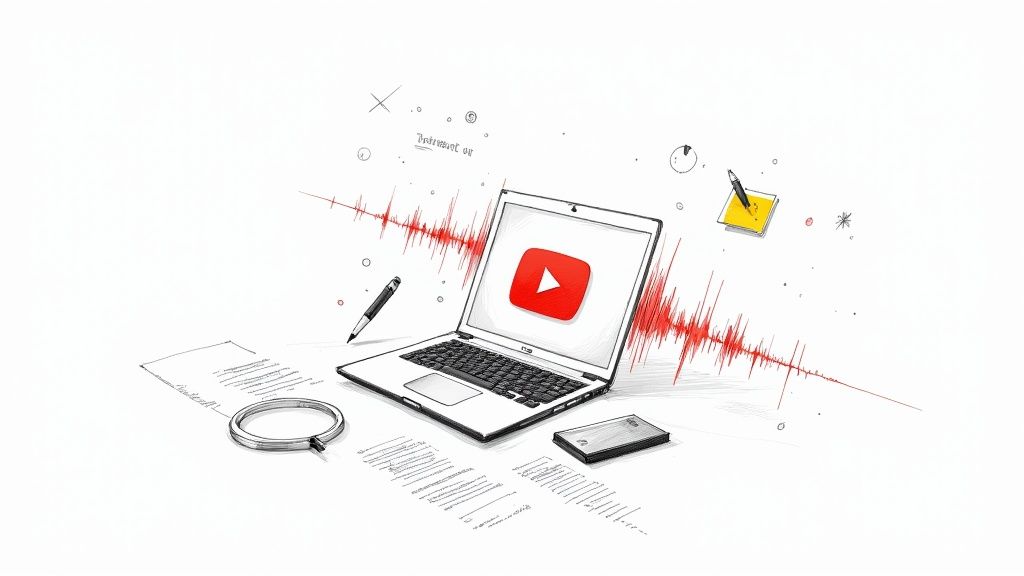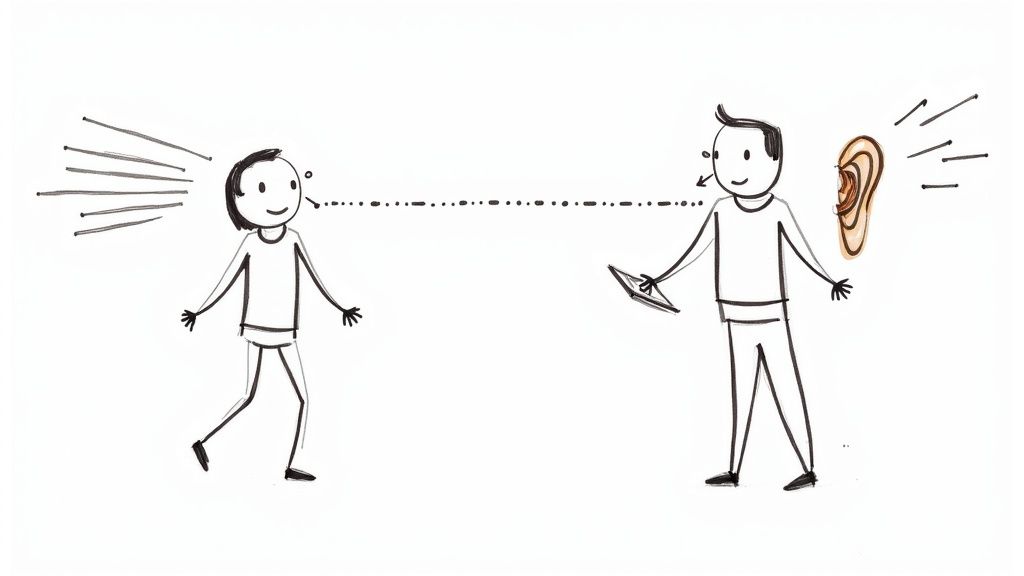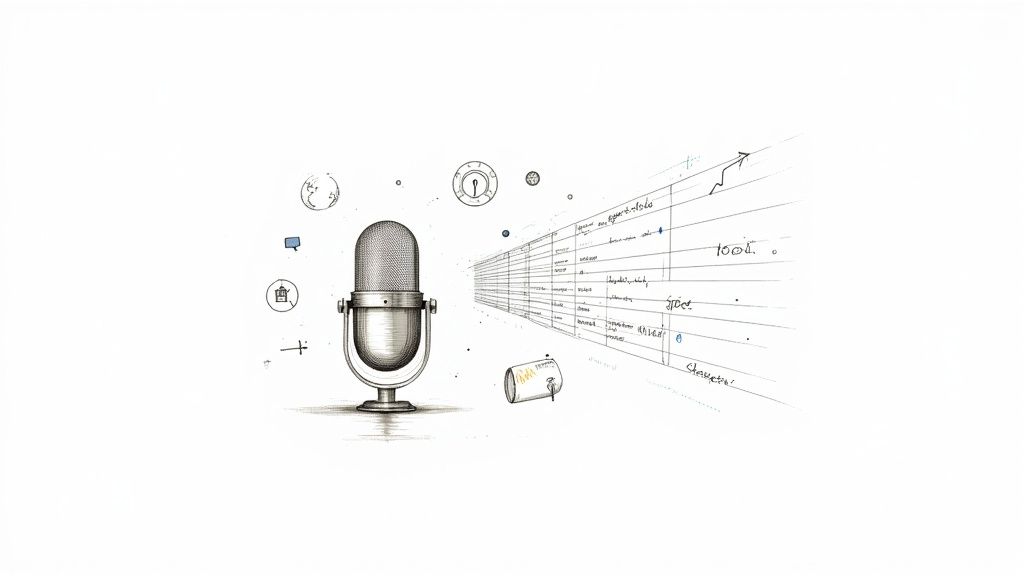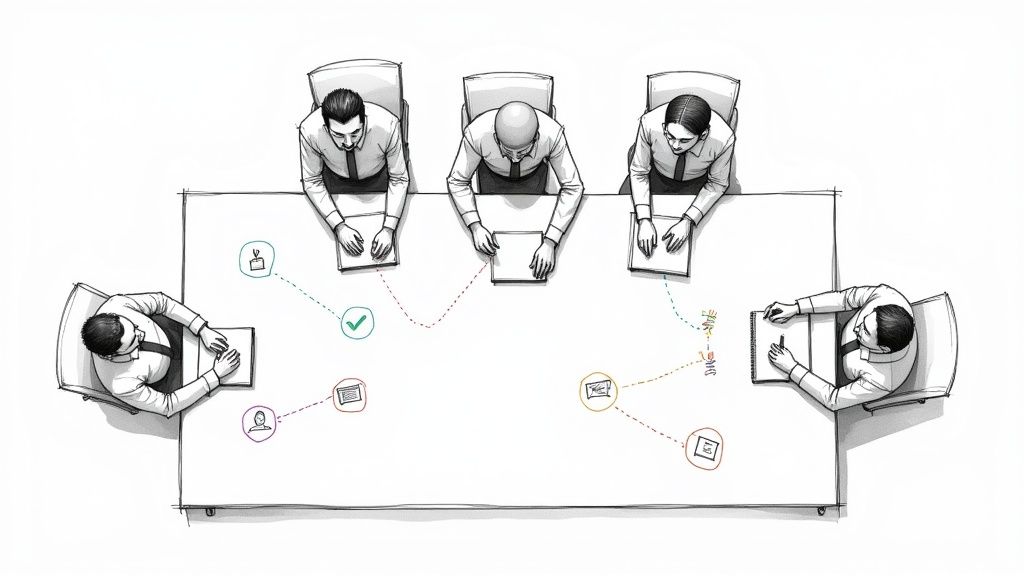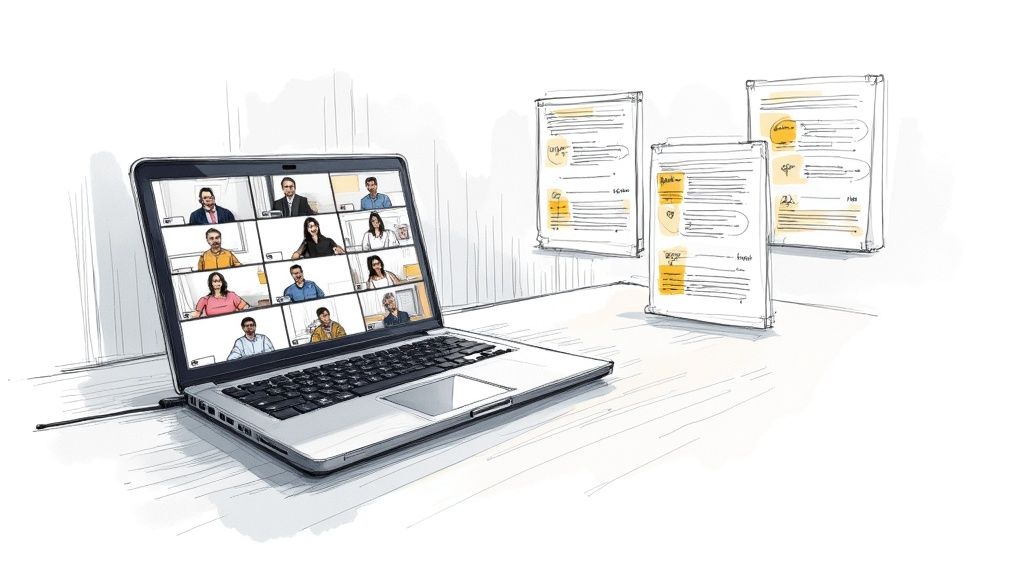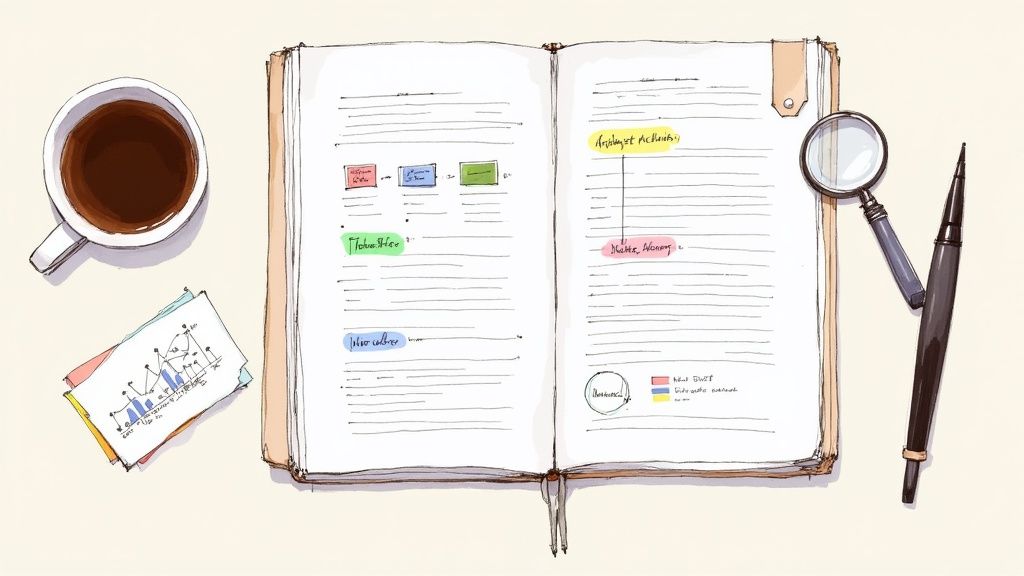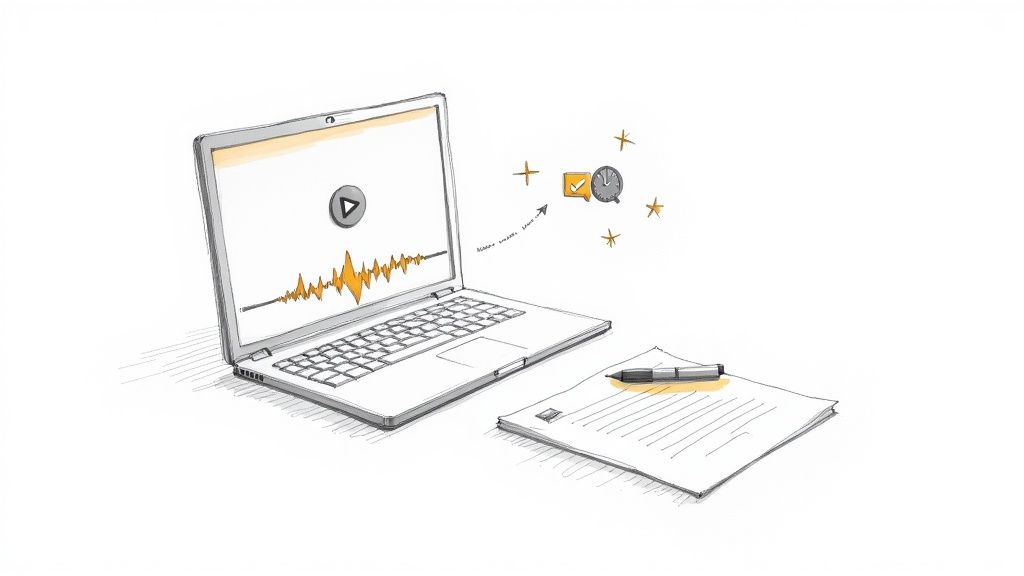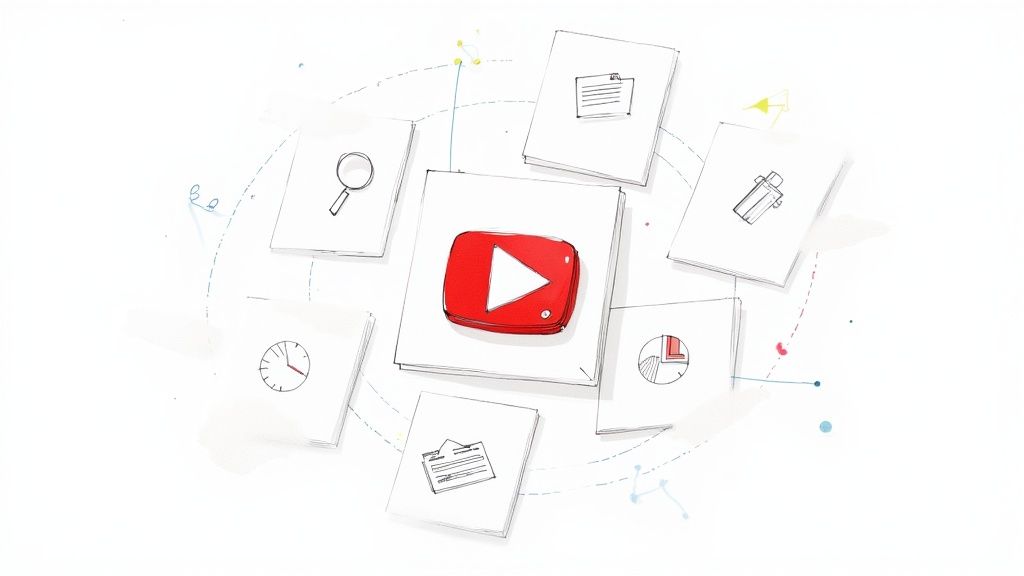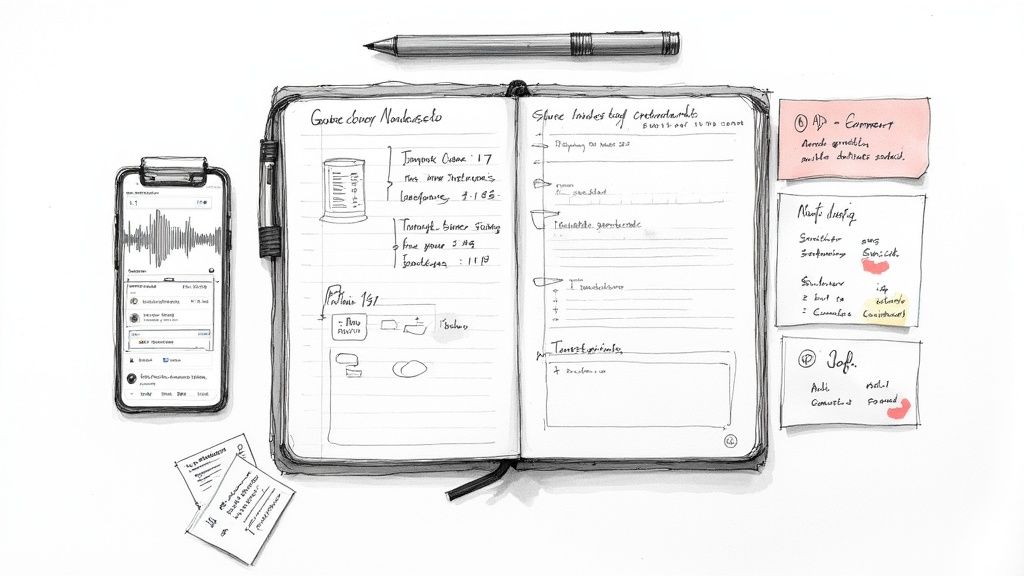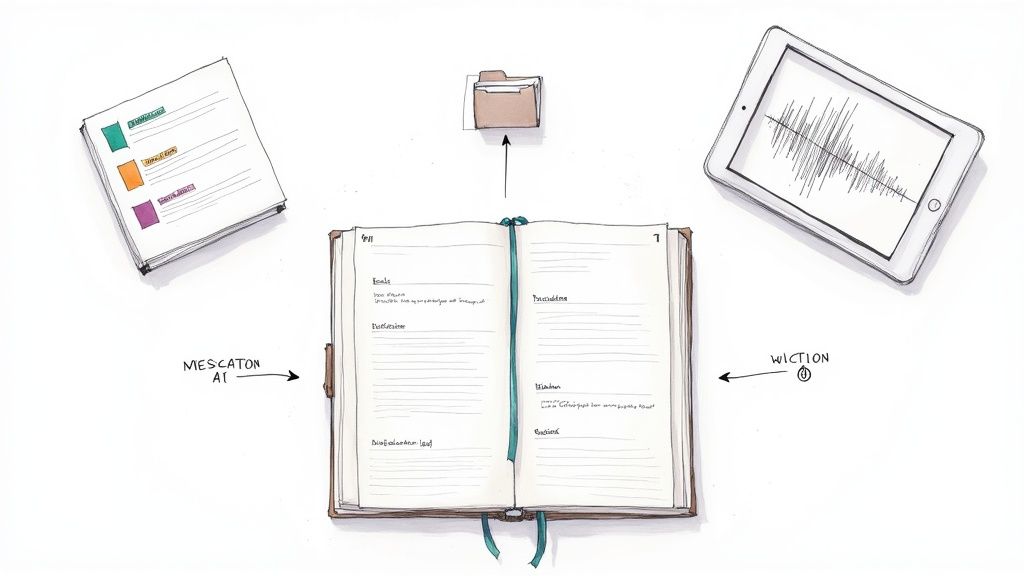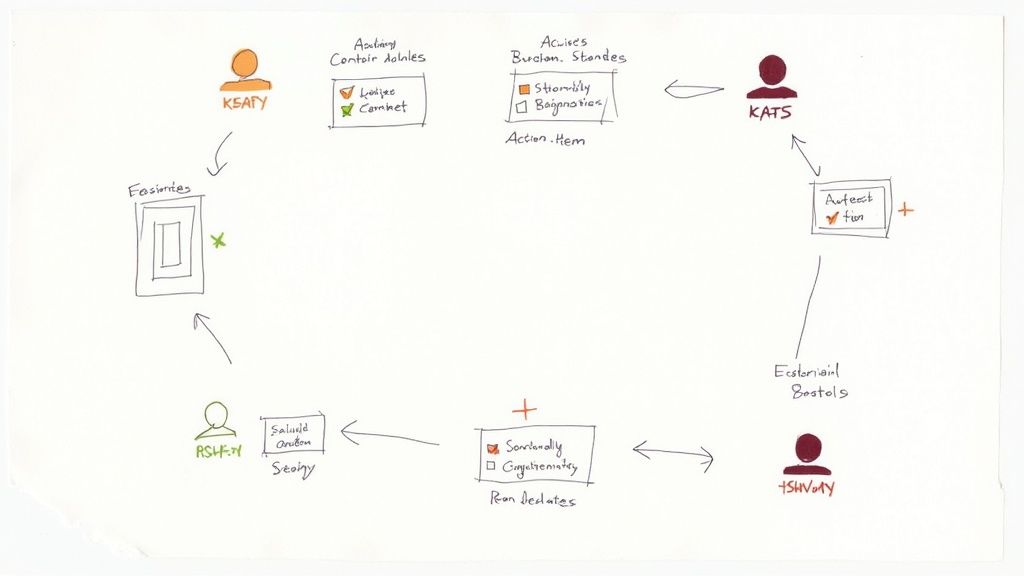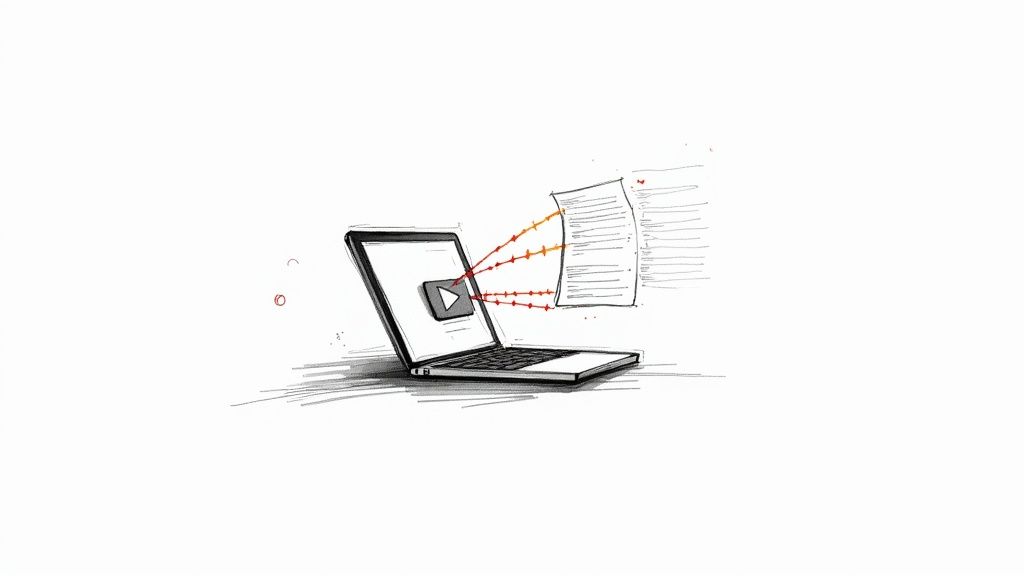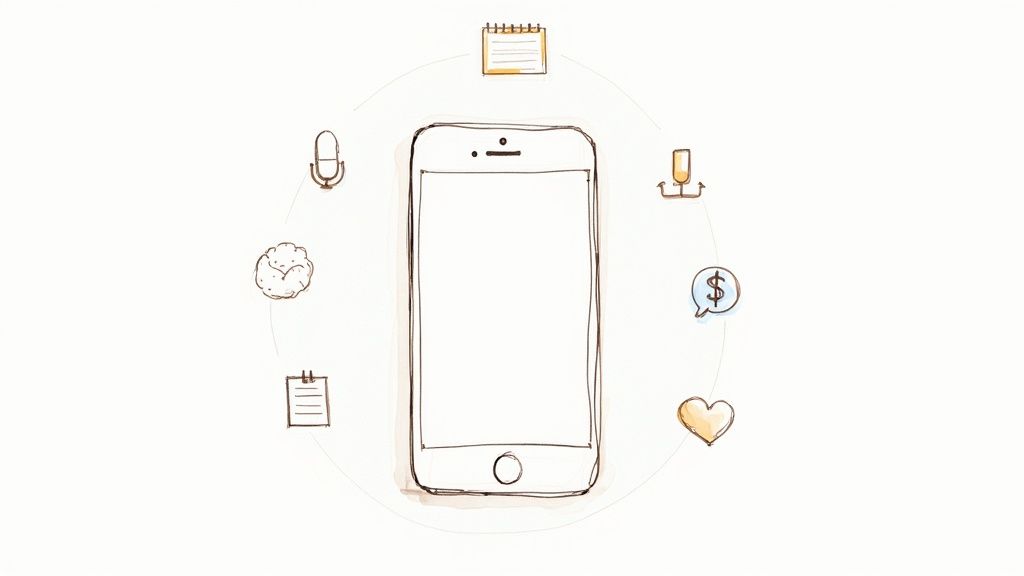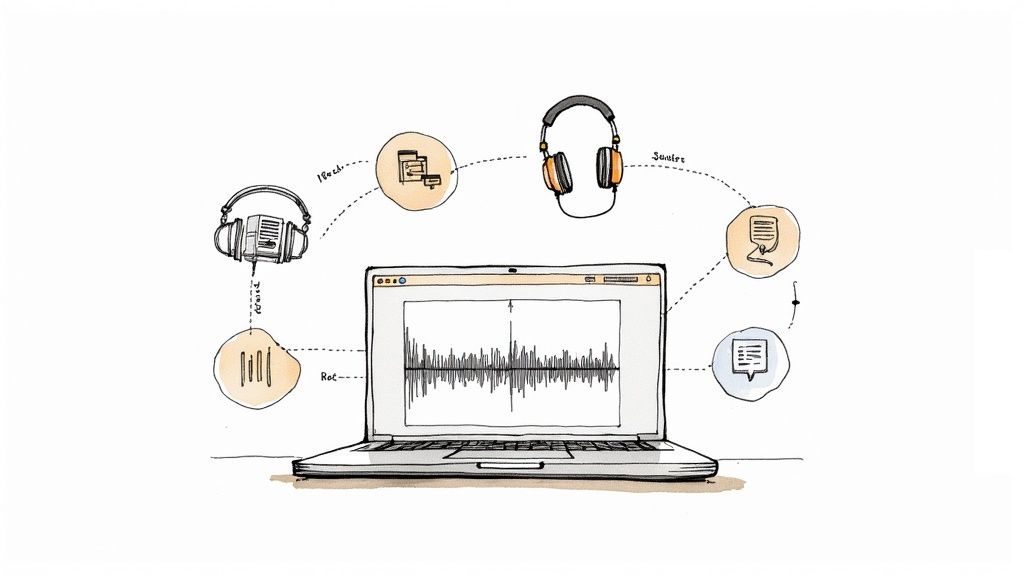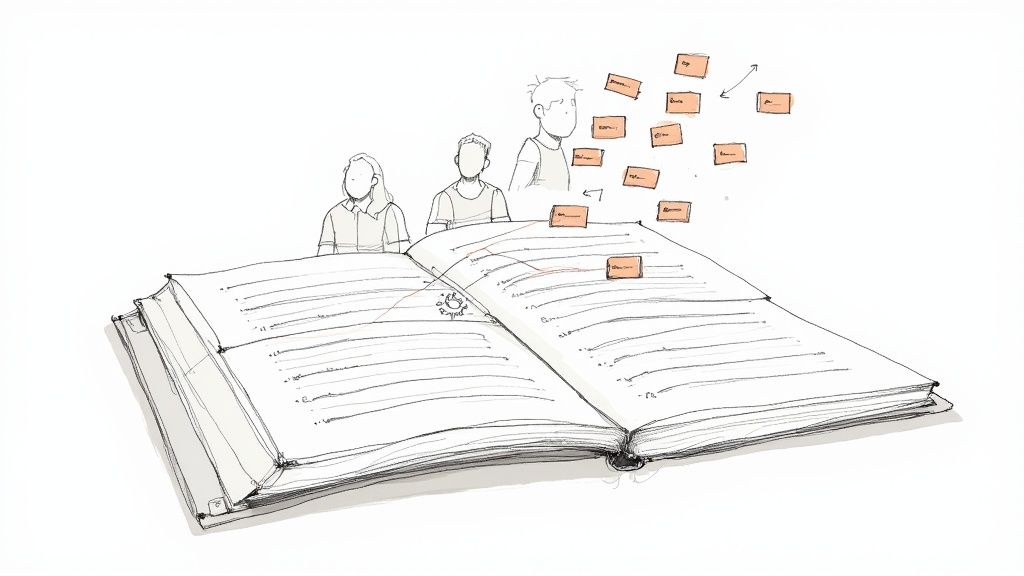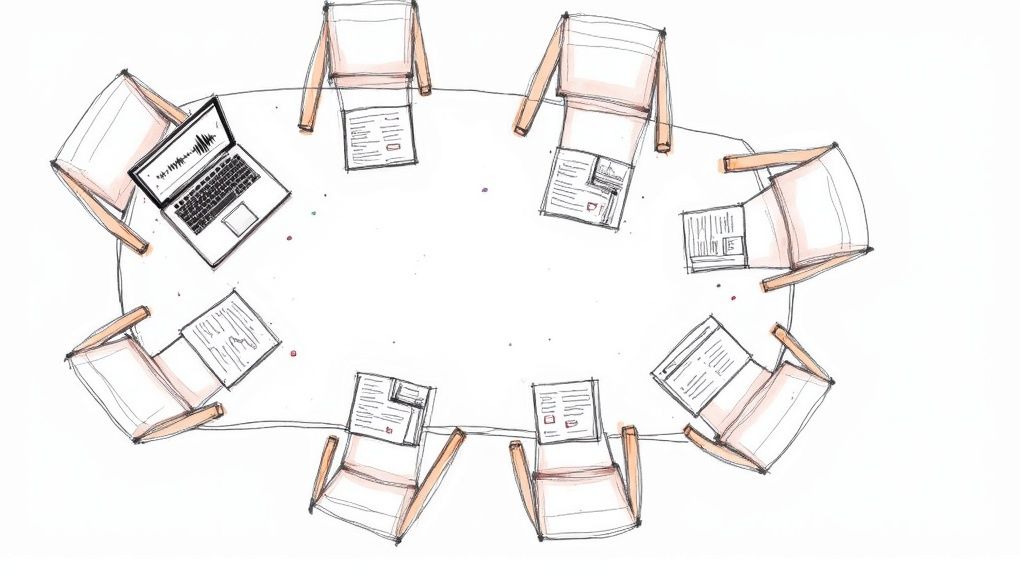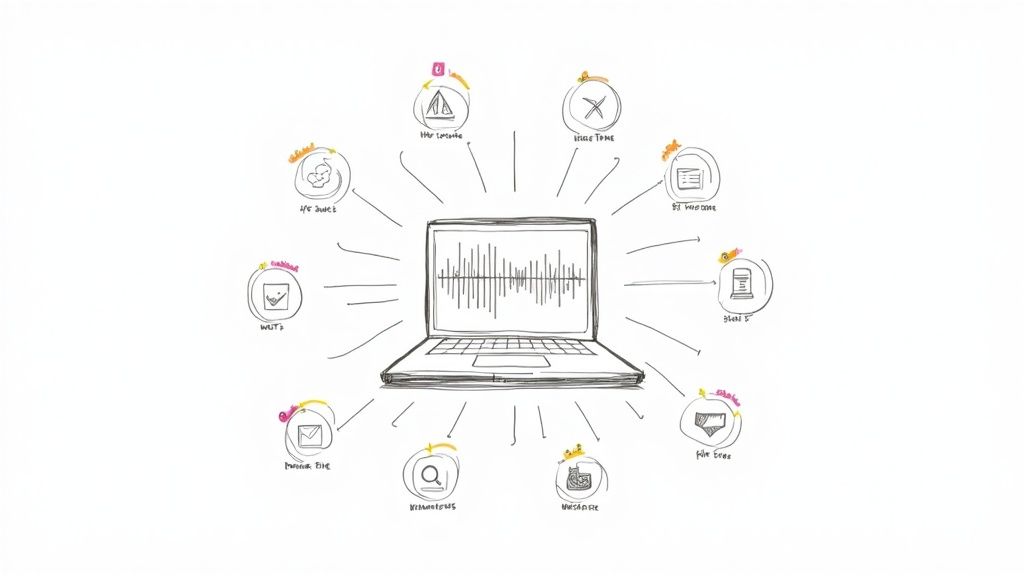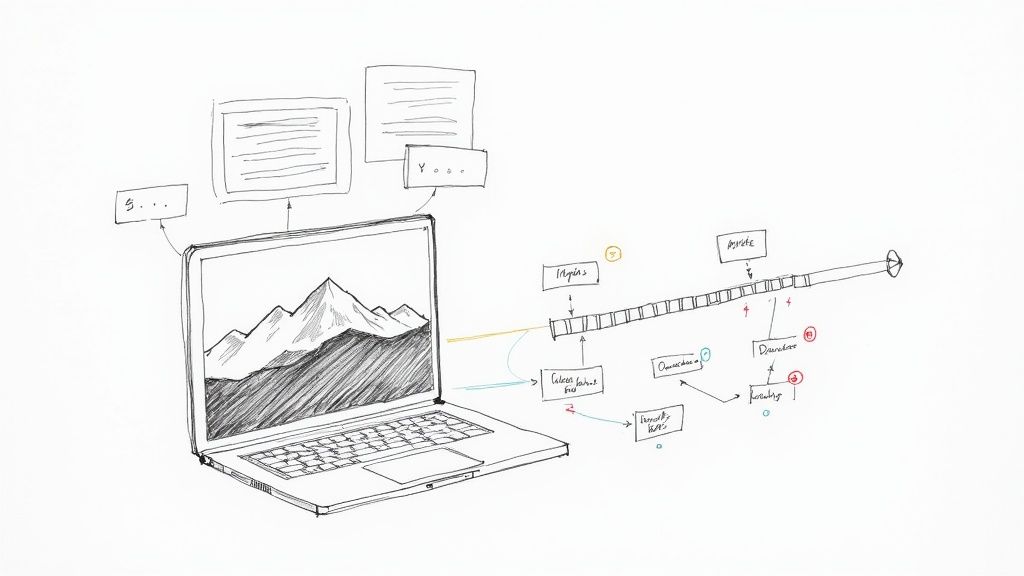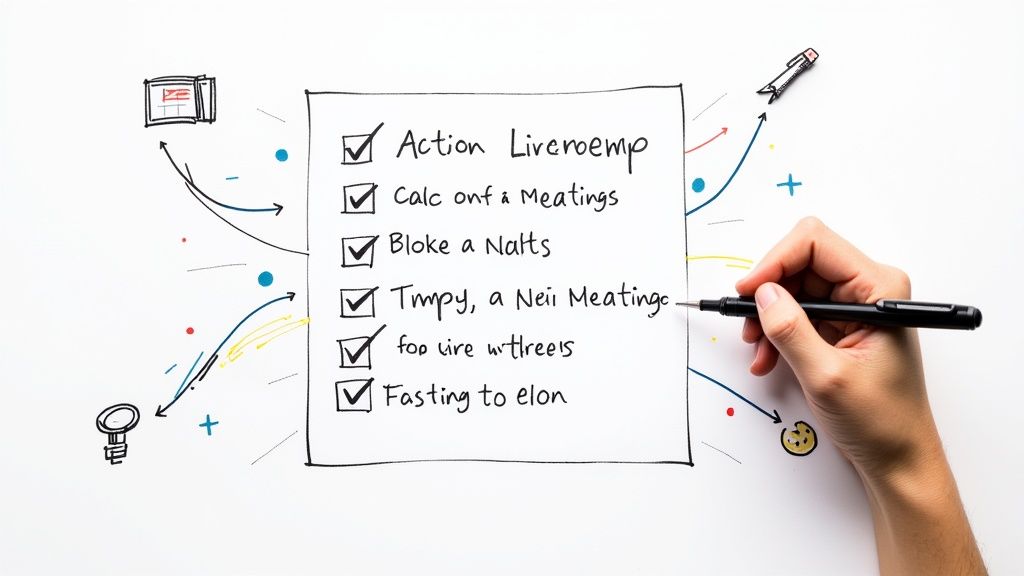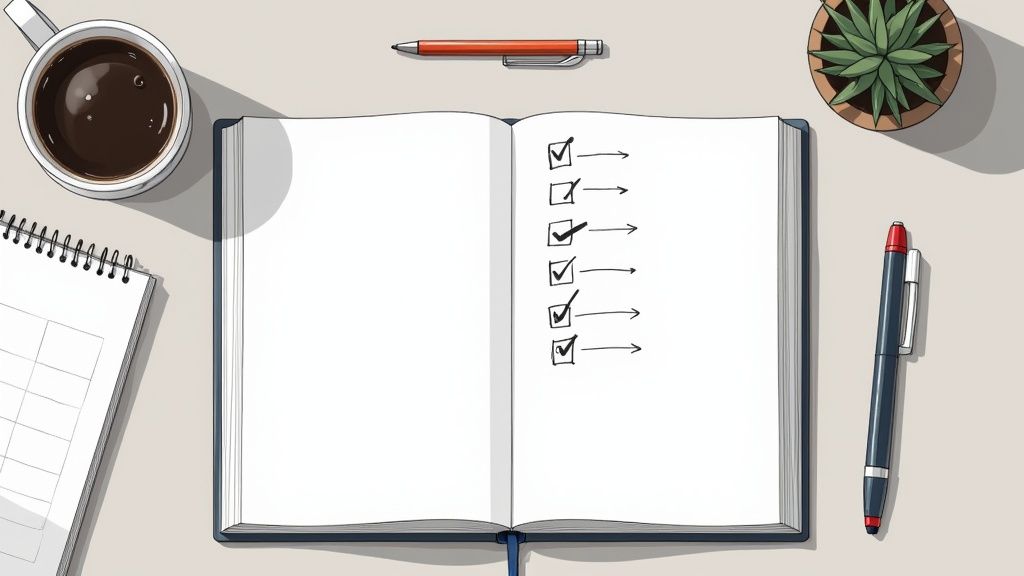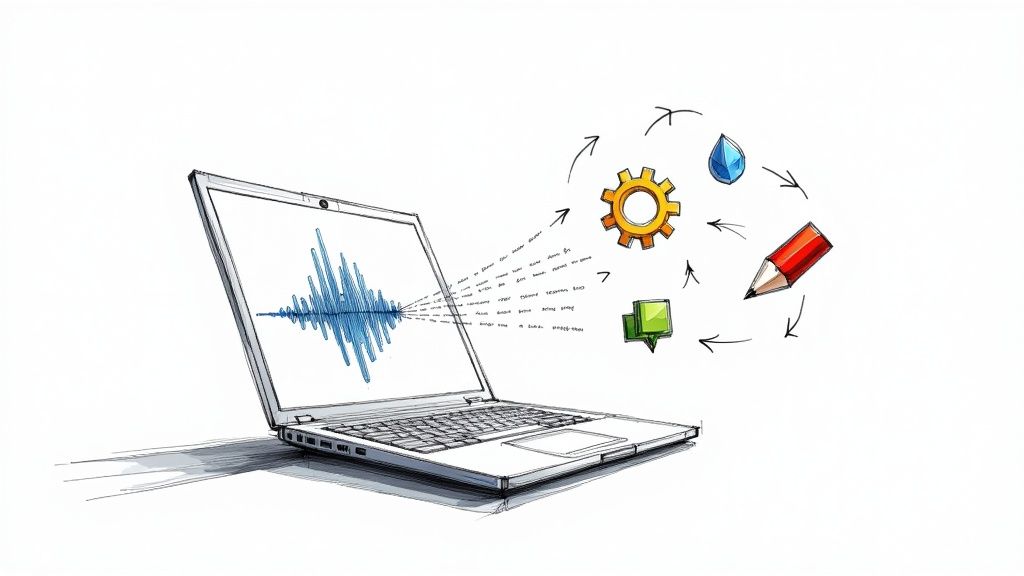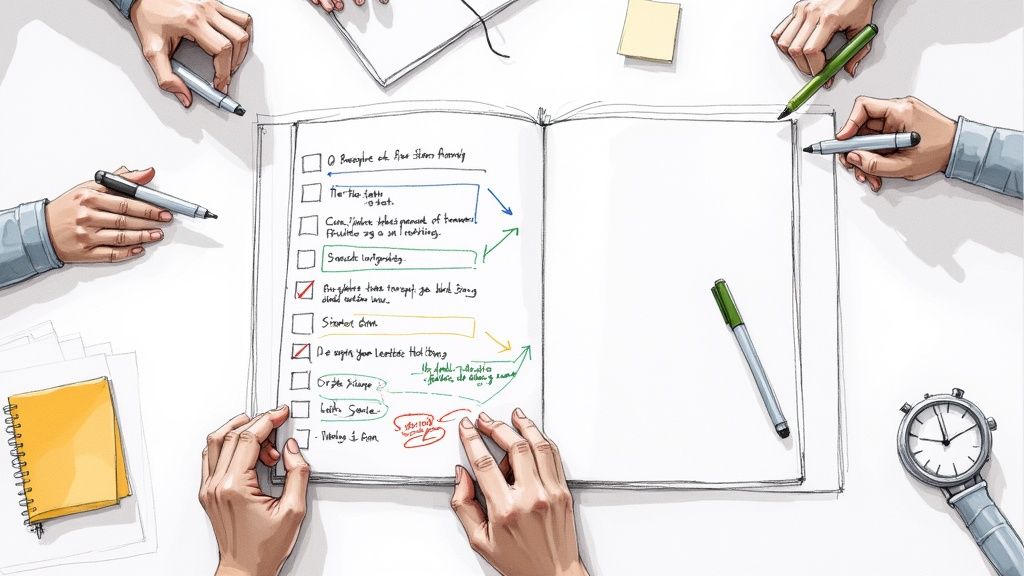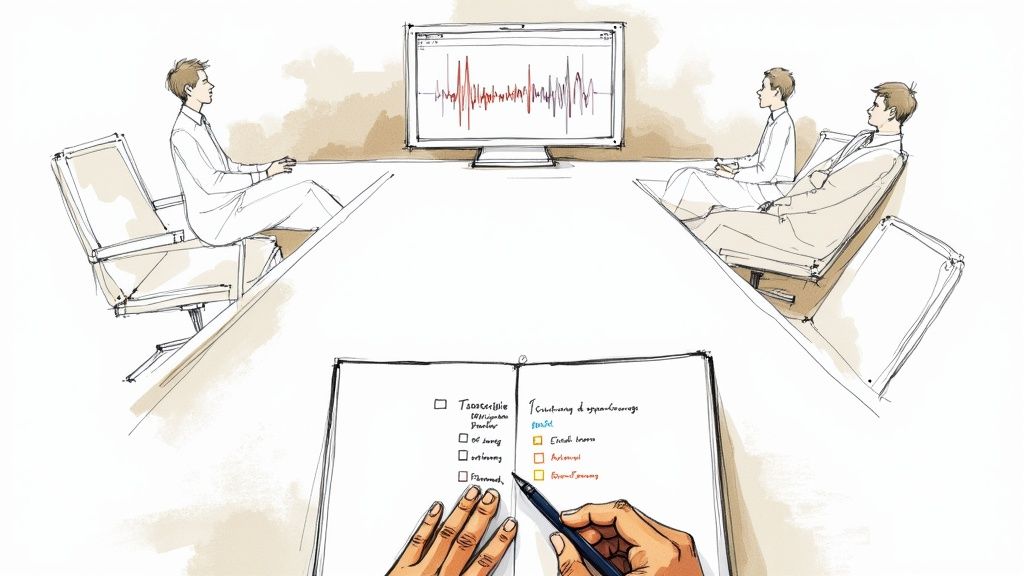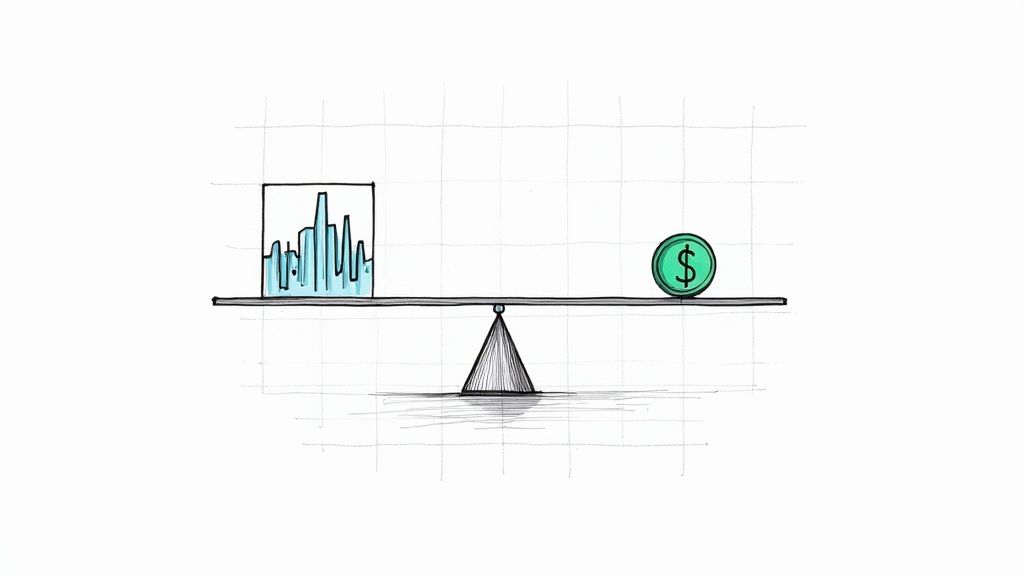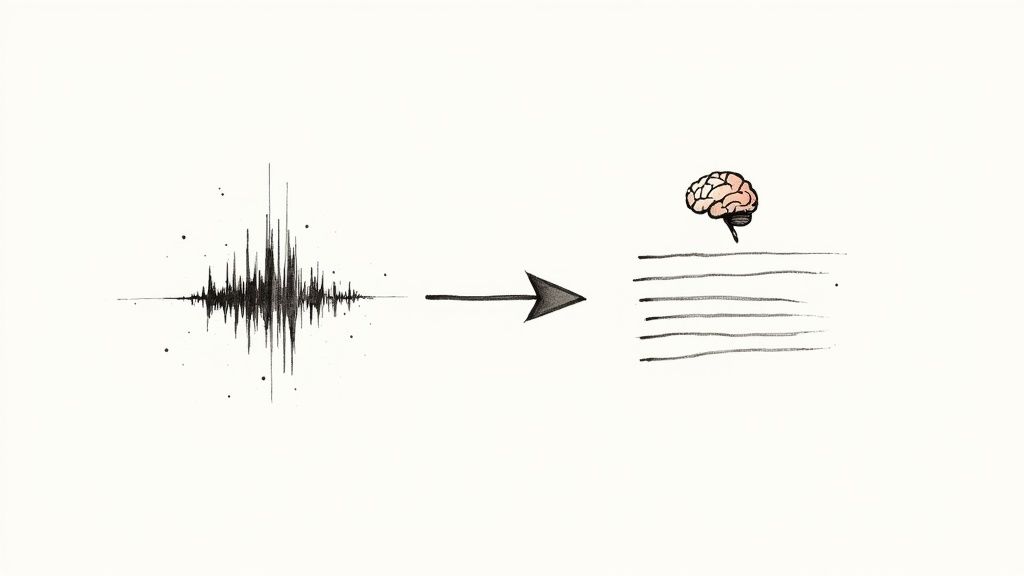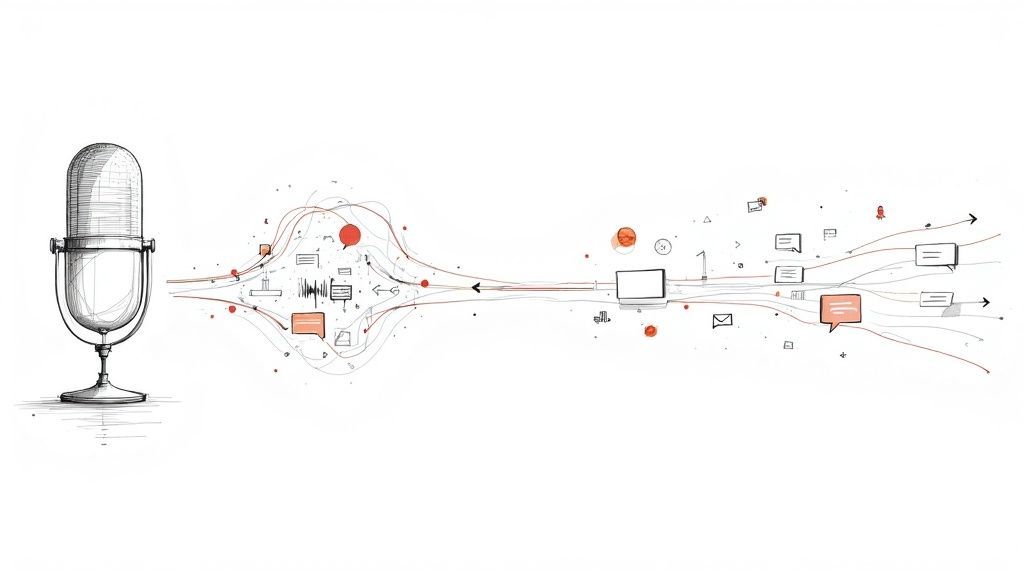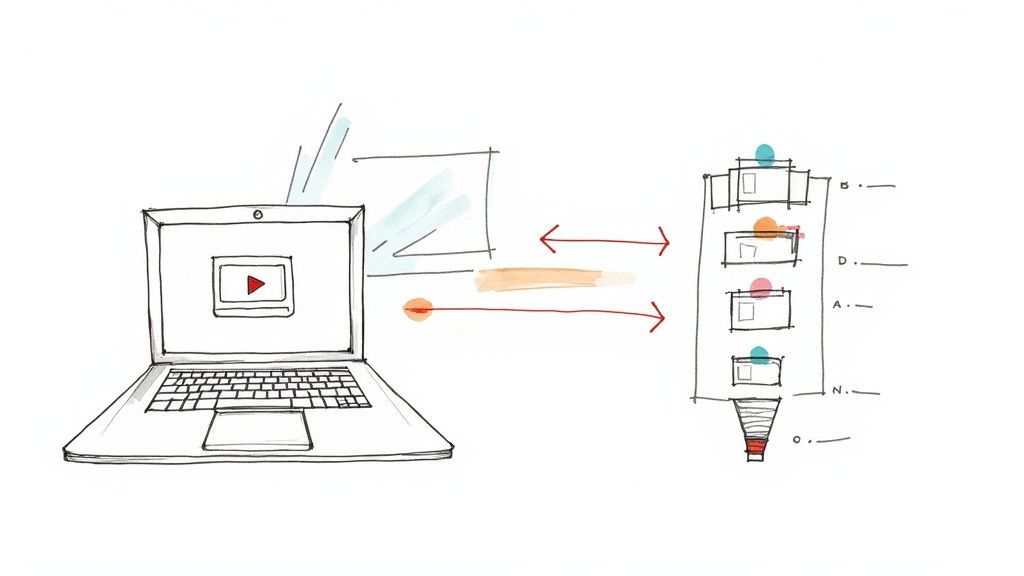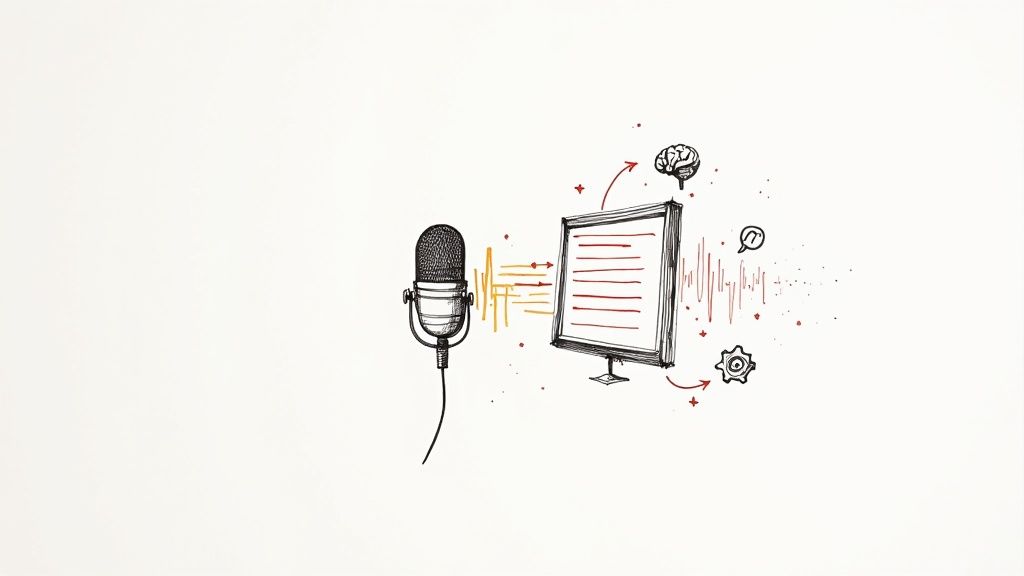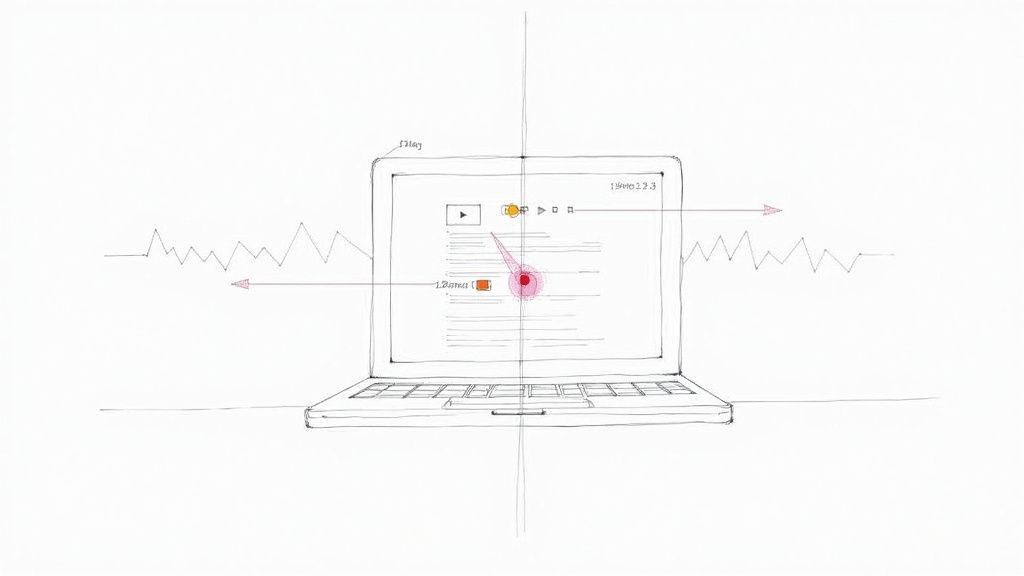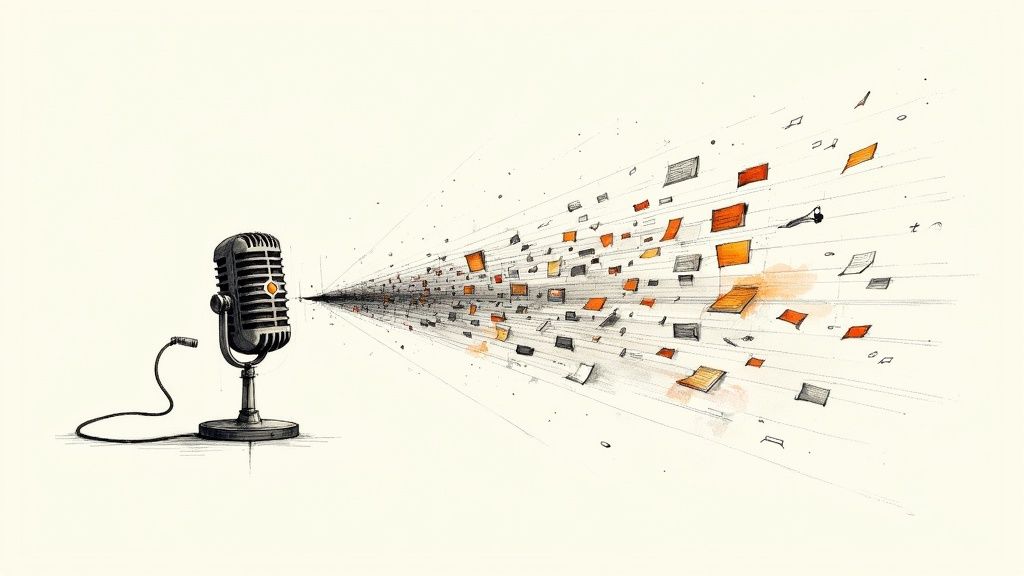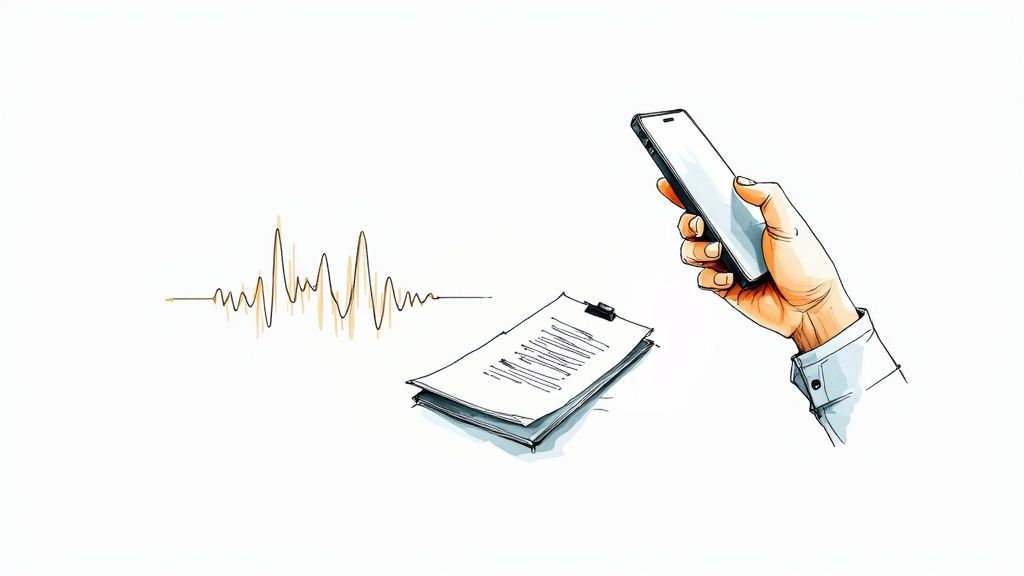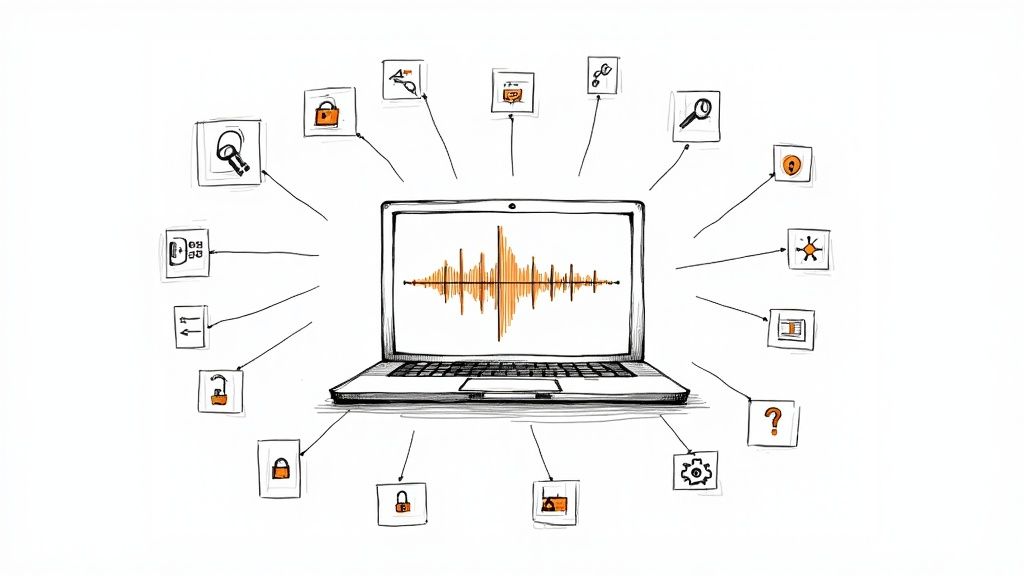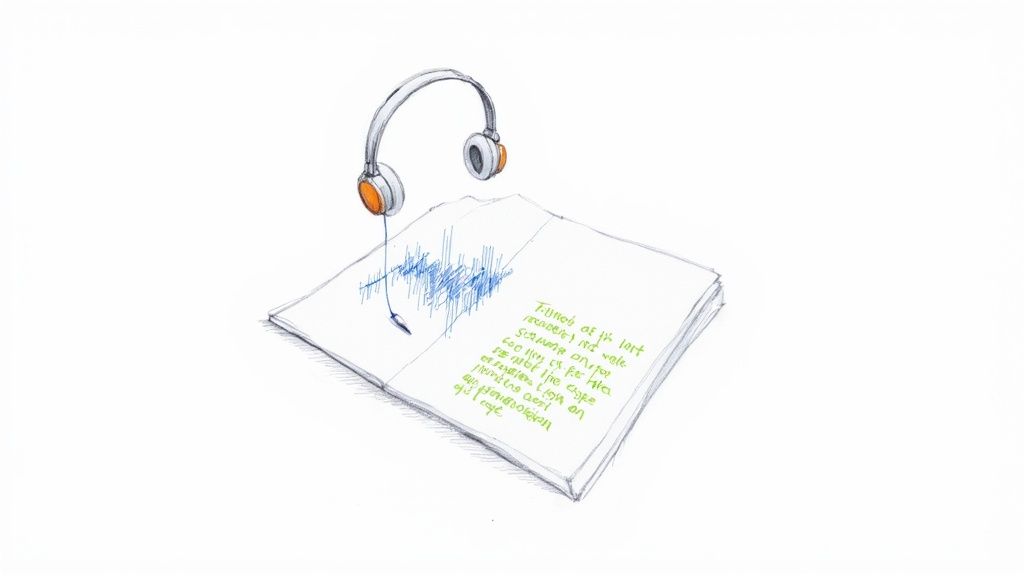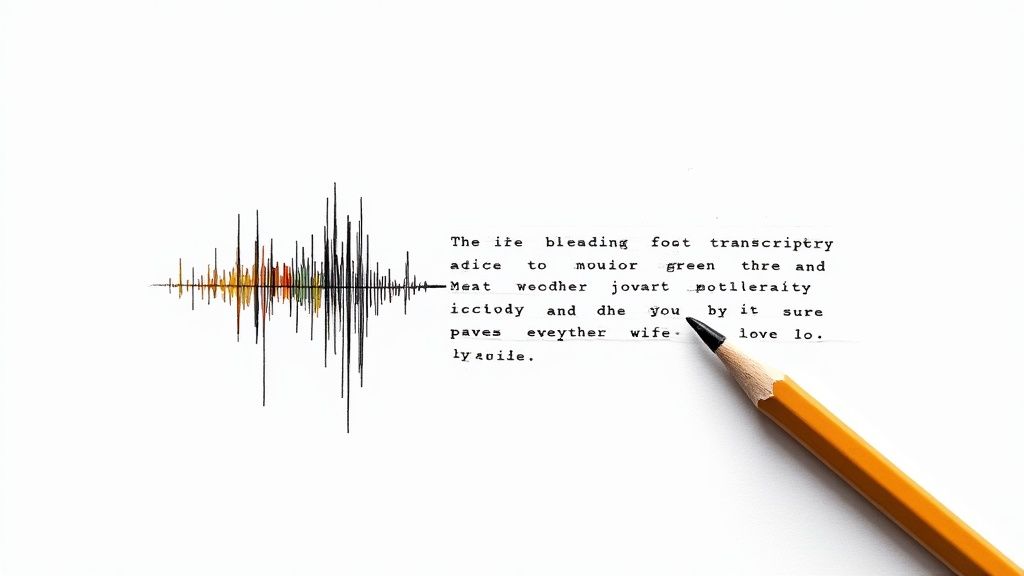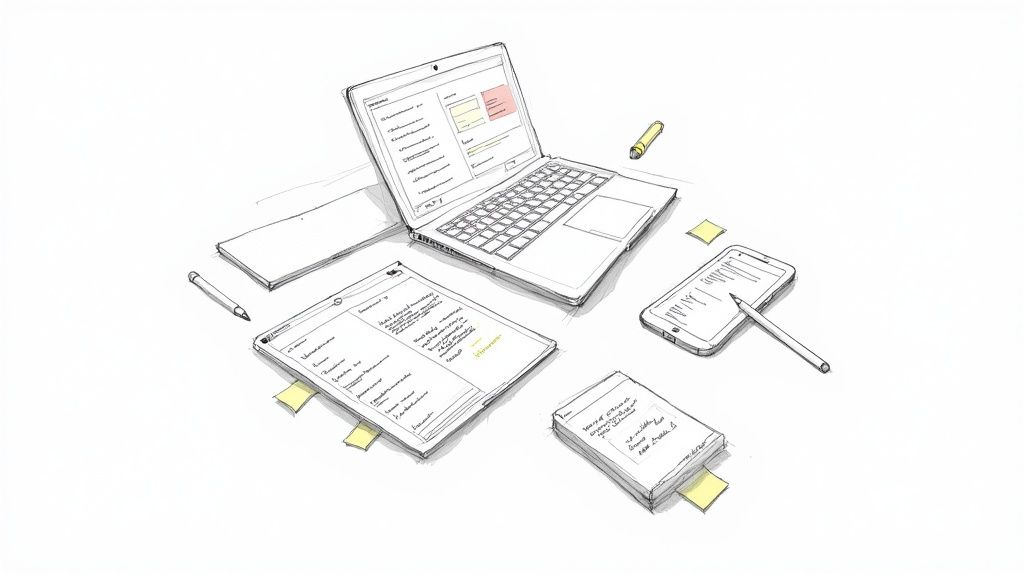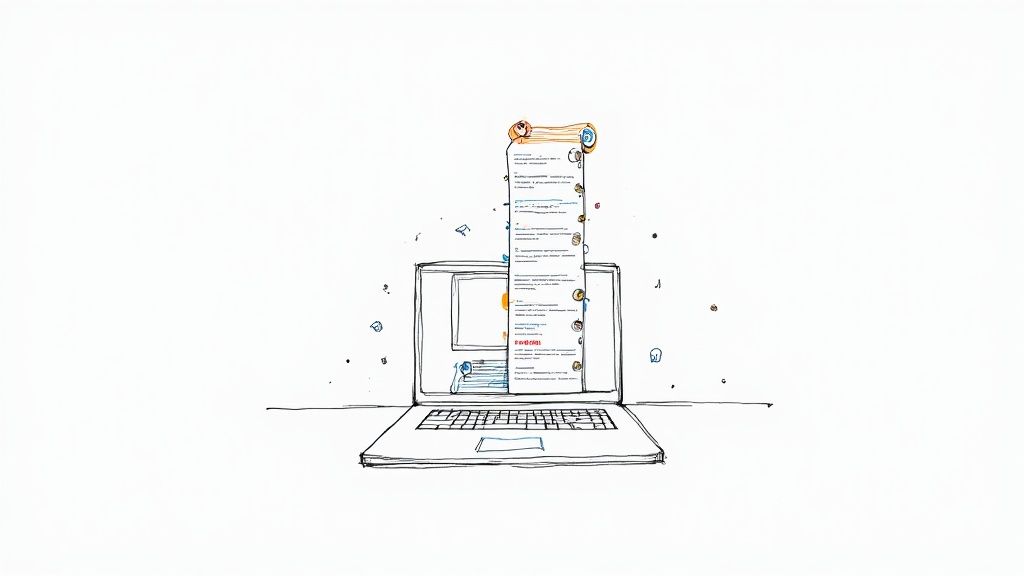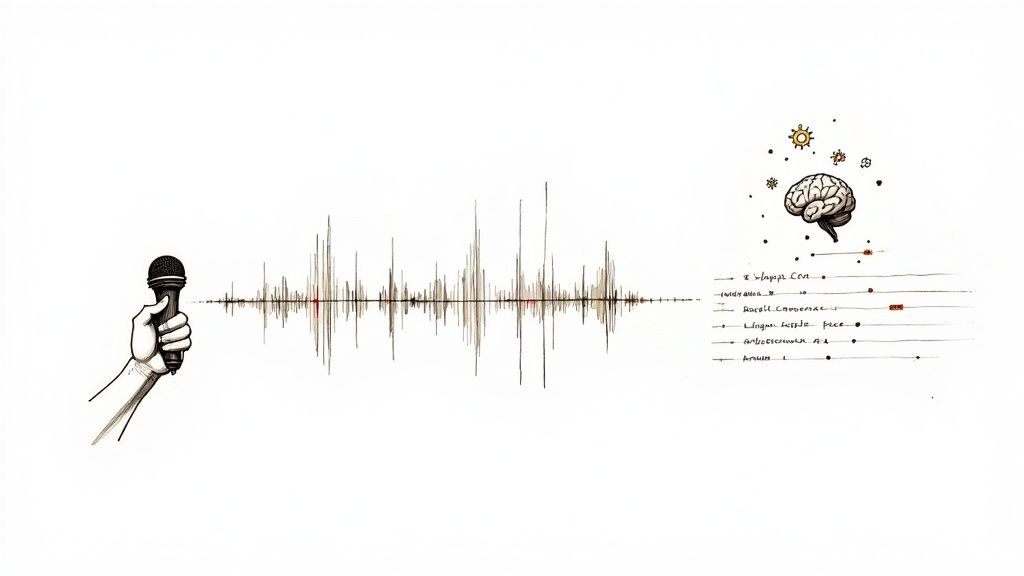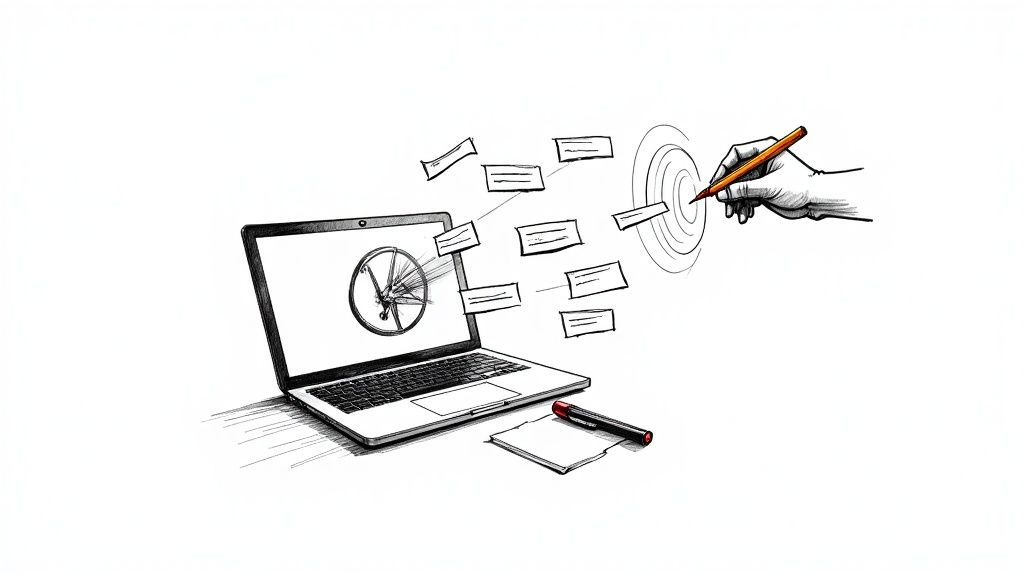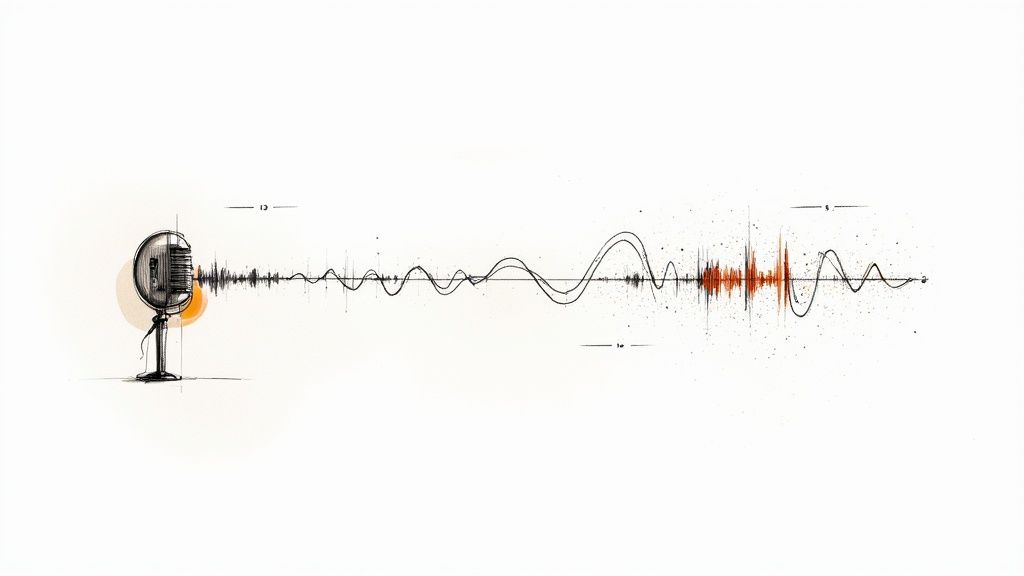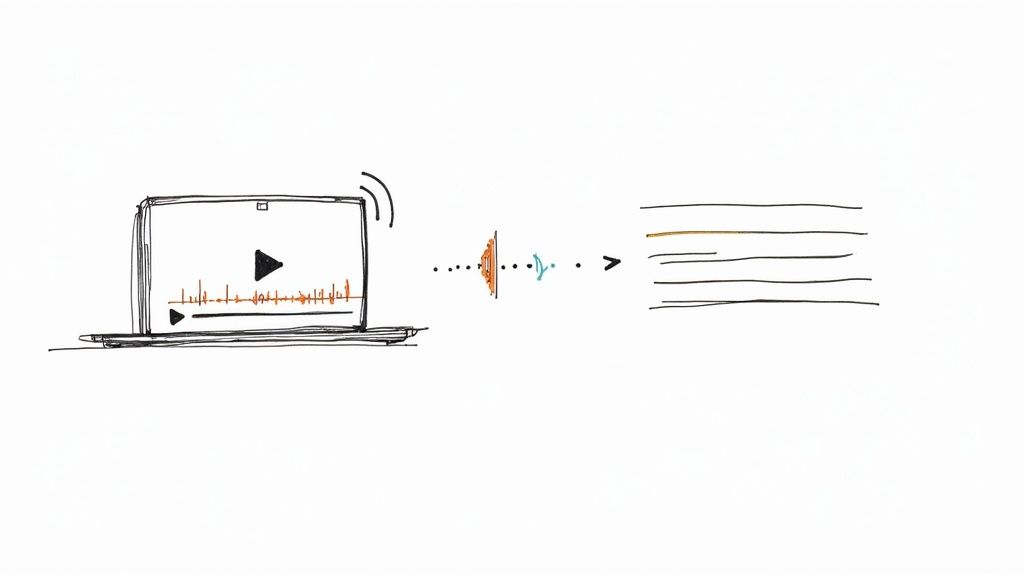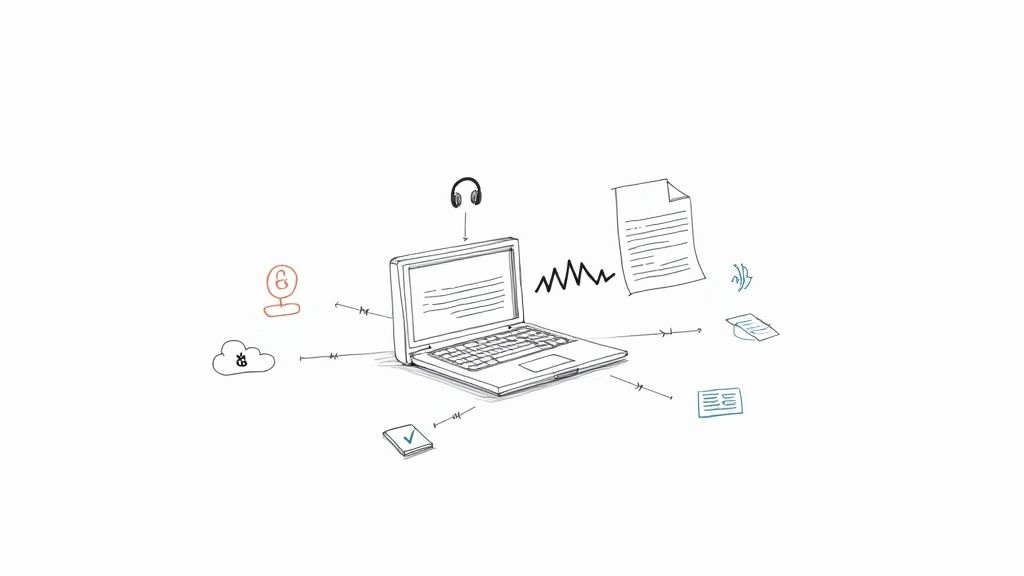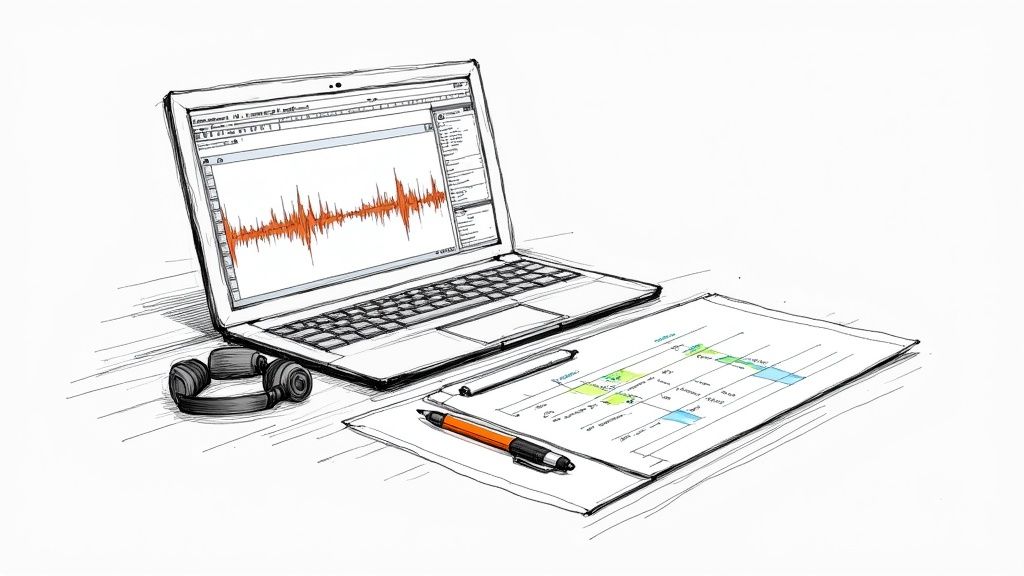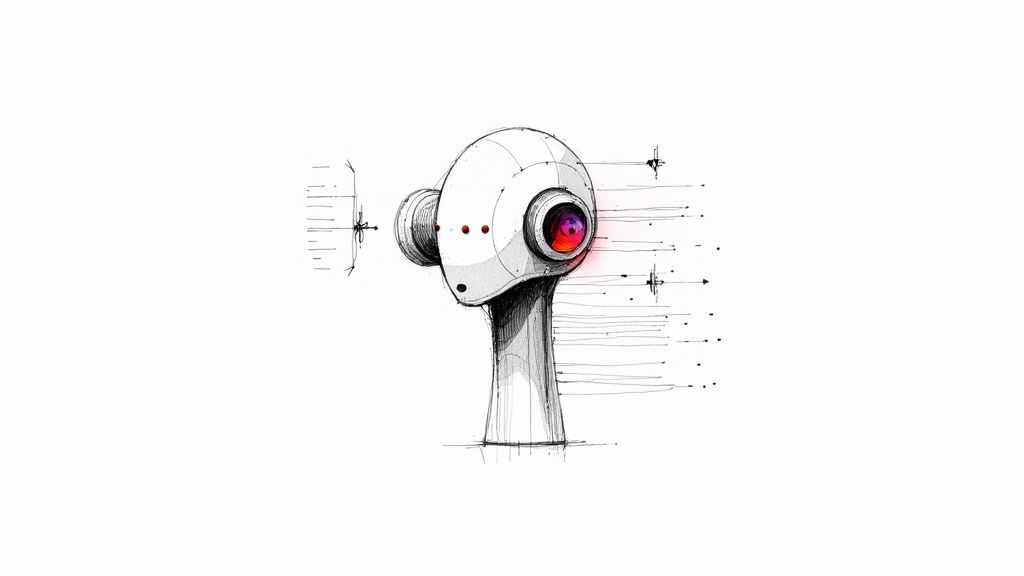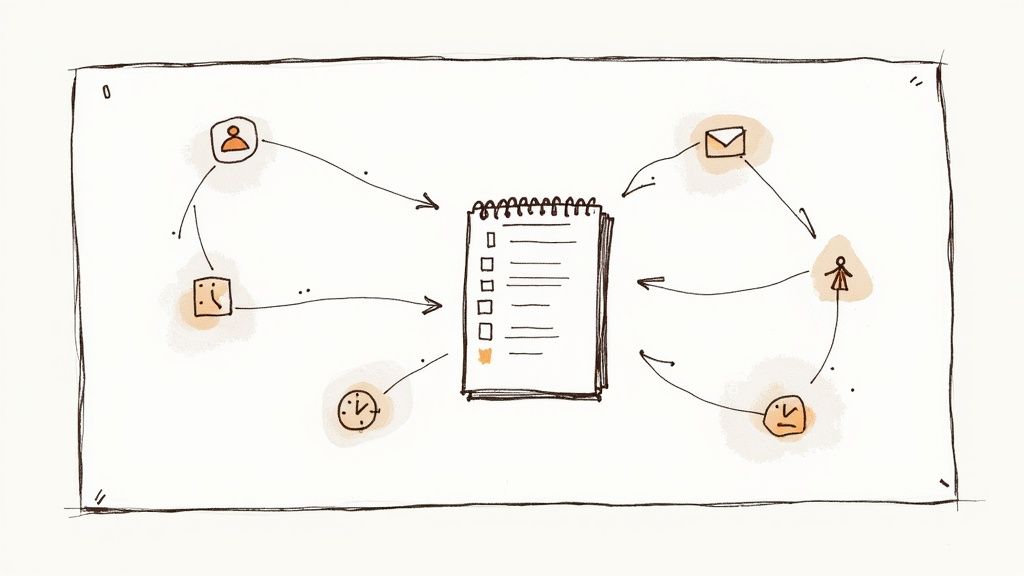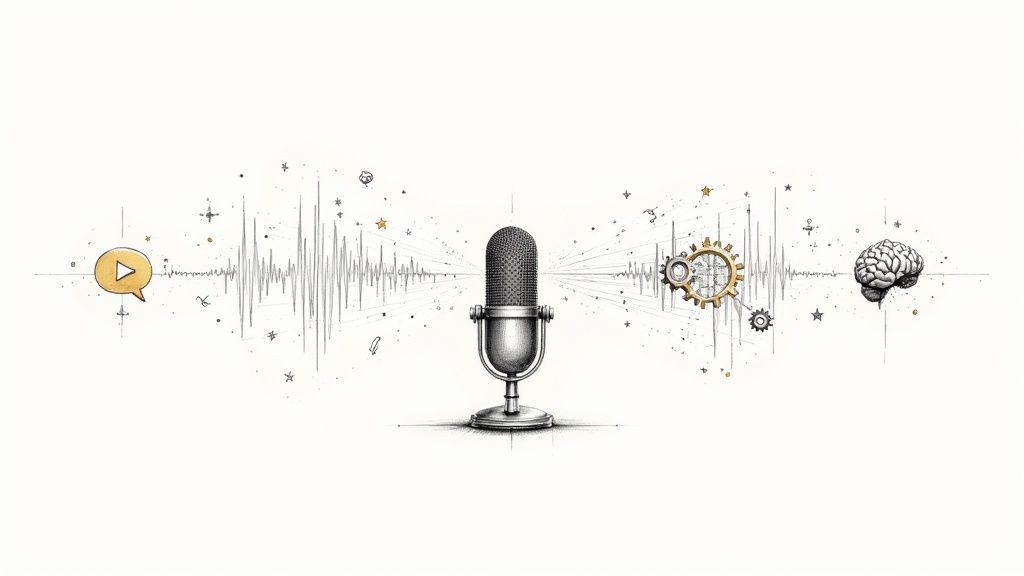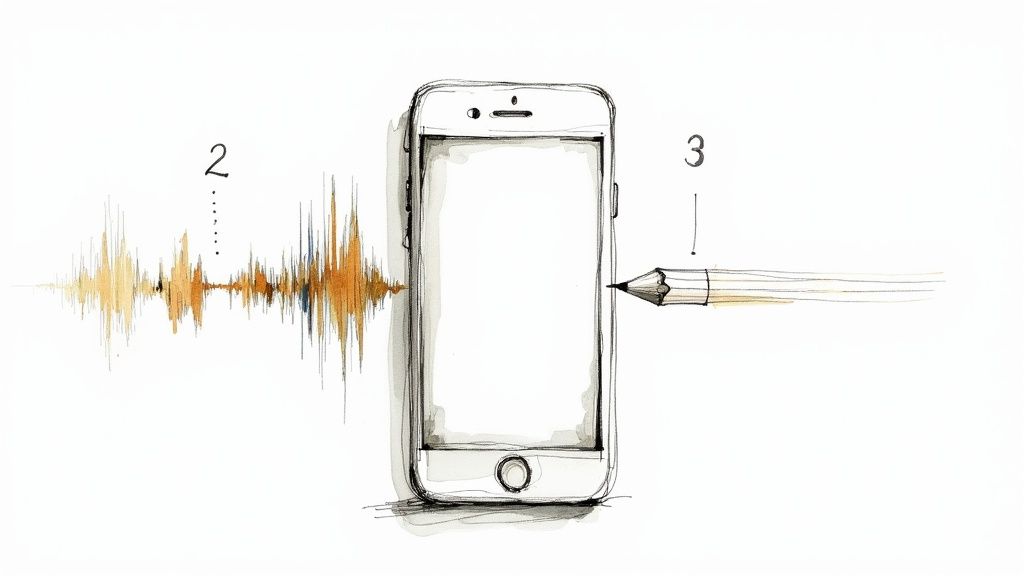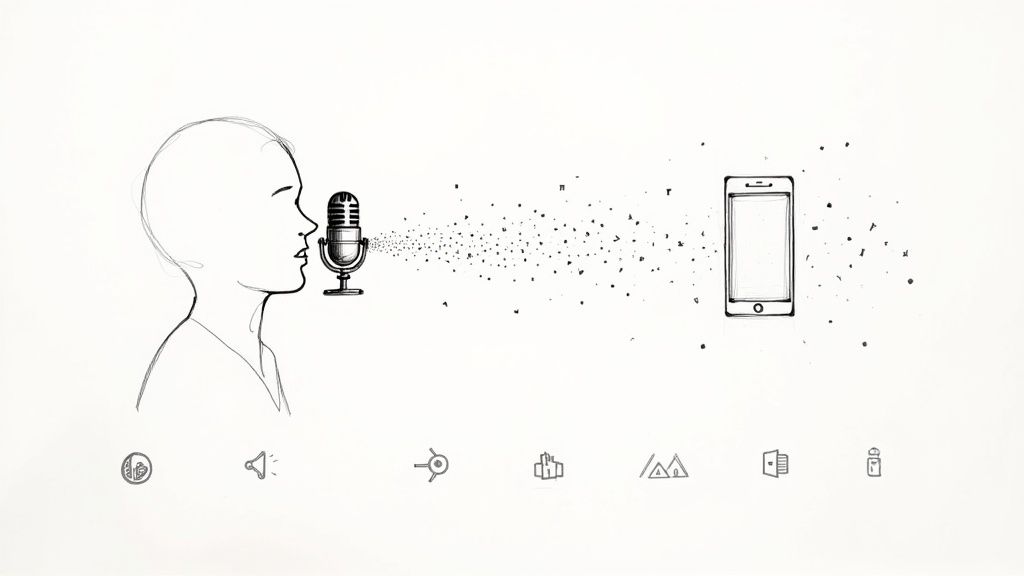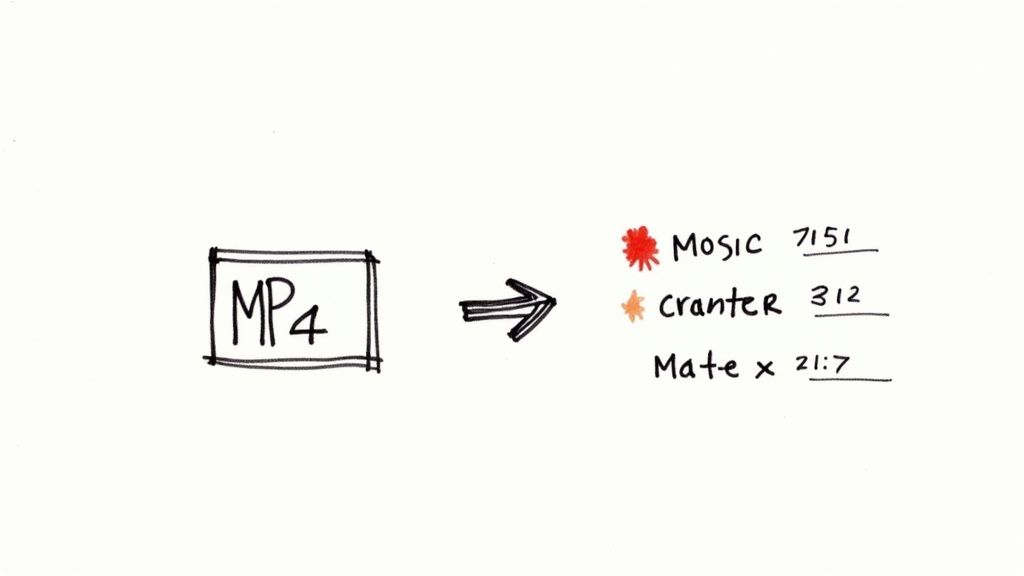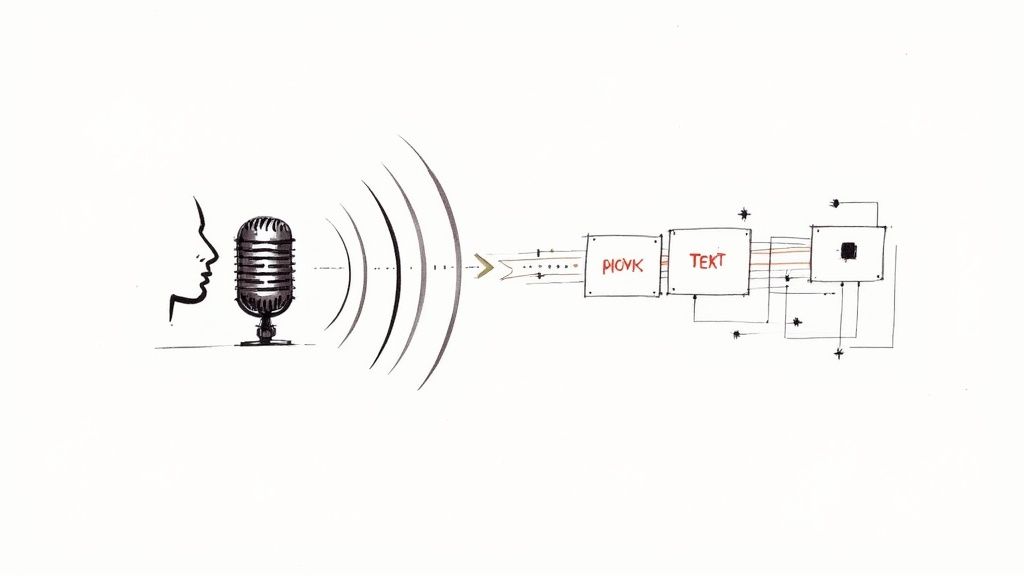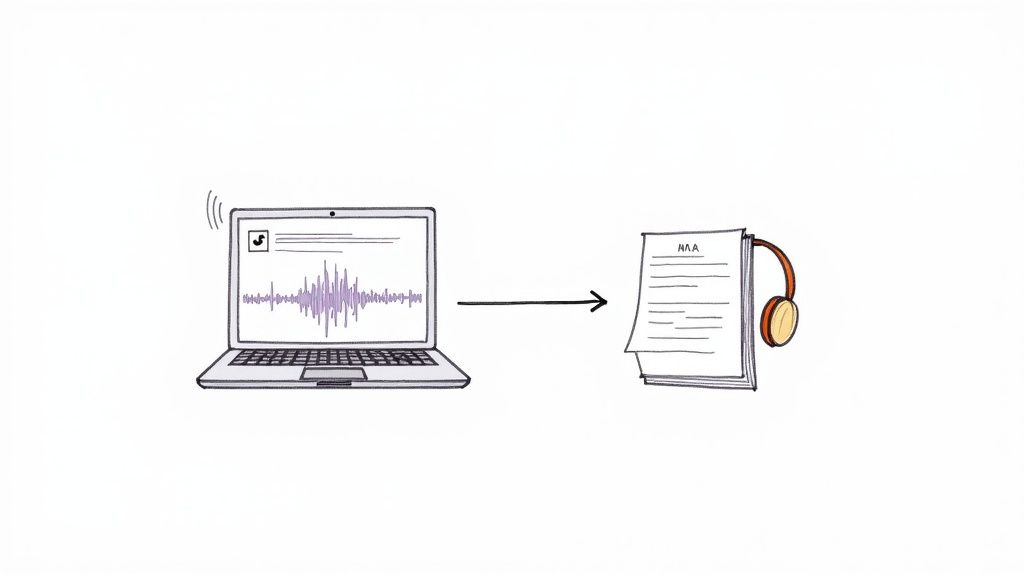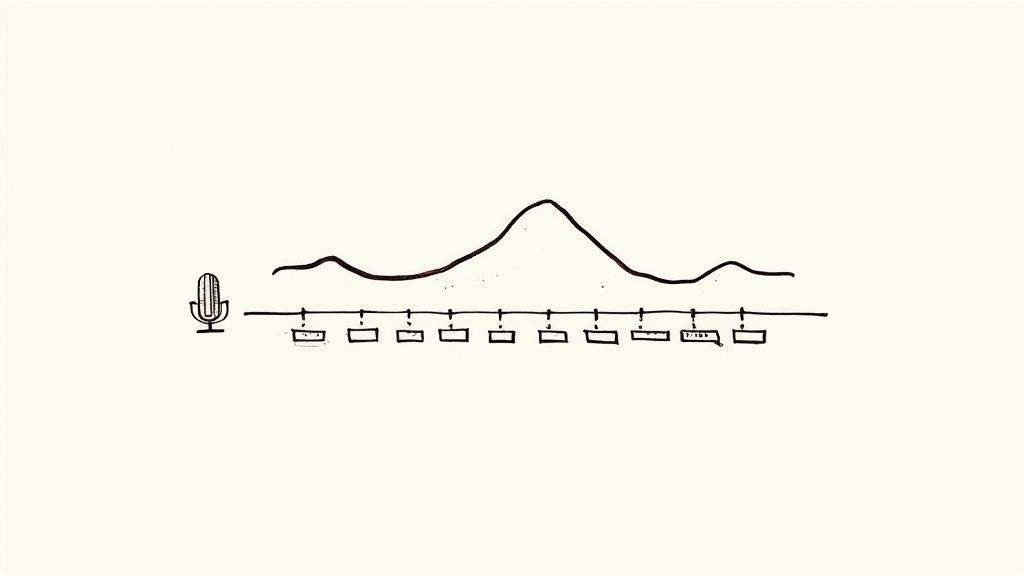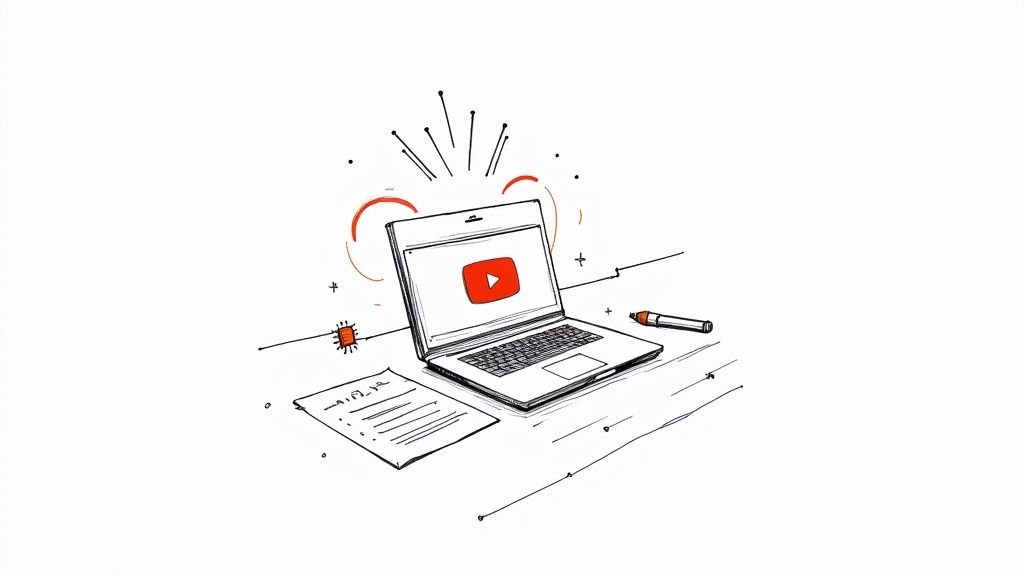
A Comprehensive Guide to Audio Transcription
Fundamentally, transcription is the process of converting spoken words from an audio or video recording into written text. From my experience, it's best to think of it not just as typing, but as translating a dynamic conversation, lecture, or interview into a static document you can easily read, edit, and search.
What Is Transcription And Why It Matters
Transcription is much more than just a mechanical task of typing out what's said. It's the critical first step to unlocking the valuable information trapped inside your audio and video files. Years ago, this was a painstaking manual job requiring hours of focused listening. Today, it’s a powerful workflow that often blends human expertise with smart technology.
This process builds a bridge from a spoken idea to a piece of content you can actually use. Without it, the brilliant insights from a two-hour podcast or a key business meeting are locked away, difficult to reference or share. When you convert that audio to text, you instantly make it searchable, scannable, and far more versatile.
Unlocking Your Content's Potential
The real-world applications for transcription are massive. It's no longer just for journalists or paralegals; it's an essential tool for anyone who creates and works with media today.
Here’s a practical look at what transcription can do for creators and teams:
- Boosts Accessibility: Transcripts and captions make your video content accessible to people who are deaf or hard-of-hearing. They also help anyone who prefers to watch videos with the sound off.
- Improves SEO: Search engines can’t listen to your podcast or watch your video, but they excel at reading text. A transcript allows them to crawl every word, helping you rank for all the keywords you mention.
- Enables Content Repurposing: A single webinar can be transformed into a dozen different assets. You can pull out impactful quotes for social media, turn a key section into a blog post, or build a detailed guide from the discussion.
- Enhances Data Analysis: For researchers and marketers, transcripts are a goldmine. You can quickly search for themes, keywords, and customer feedback, turning unstructured conversations into organized insights.
The real power of transcription lies in its ability to transform passive media into active, searchable data. It gives your spoken words a second life as a versatile digital asset.
A Rapidly Growing Industry
The surging demand for transcription underscores its importance. The U.S. transcription market was valued at around USD 30.42 billion in 2024 and is expected to keep growing, showing just how widely it’s being adopted in almost every field.
This growth is driven by the explosion of audio and video content online and the increasing need for businesses to make every piece of content count. If you want to dive deeper into the basics, you can explore our detailed guide on what is audio transcription. Understanding the fundamentals makes it clear why this is no longer a niche service but a core part of any modern content strategy.
Human Precision Versus Machine Speed
When it comes to getting a transcription, you're essentially choosing between two main paths. One is the meticulous, detail-oriented work of a human professional. The other is the high-speed highway paved by AI algorithms. This isn't just about choosing a person over a machine; it's about matching the right tool to what you're actually trying to accomplish.
At its core, the difference is about comprehension versus calculation. A human transcriber understands context, catches sarcasm, and recognizes the subtle emotional shifts in a conversation. An AI, on the other hand, is a master of pattern recognition, converting sounds to text with incredible speed by drawing on massive data libraries.
The Case For Human Transcription
Sometimes, you simply can't afford to be wrong. For high-stakes situations where every word and its intended meaning carry significant weight, human transcription is still the gold standard.
Think about a legal deposition. A simple pause or a moment of hesitation can completely change how testimony is interpreted. Or consider a research interview where a participant’s sarcastic tone flips the meaning of their words. These are the kinds of subtleties a machine can easily miss, but a skilled human will capture perfectly.
Here’s where a human expert is non-negotiable:
- Complex Audio: If you have a recording with a noisy background, people talking over each other, or thick regional accents, a trained human ear can decipher the chaos where an algorithm might fail.
- Industry-Specific Jargon: Medical, legal, and highly technical fields are filled with specialized terms. An AI might misinterpret this vocabulary, leading to serious errors, but a human specialist will get it right.
- Verbatim Requirements: When you need a transcript that includes every single "um," "ah," and stutter for discourse analysis, a human is far more reliable for that level of detail.
In short, human transcription is your go-to when nuance, context, and near-perfect accuracy are your top priorities. It's an investment in quality for content where a mistake just isn't an option.
The Power Of AI Transcription
While the human touch is irreplaceable for certain jobs, the sheer volume of audio and video we create today demands a solution built for speed and scale. This is where AI has completely changed the game. AI-powered services can process hours of audio in minutes, offering a turnaround that was once unimaginable.
This technology is making a massive impact. The AI transcription market was valued at an estimated USD 4.5 billion in 2024 and is expected to rocket to USD 19.2 billion by 2034. That explosive growth is fueled by AI's ability to deliver surprisingly accurate results—often reaching up to 99% accuracy under ideal audio conditions.
This infographic gives a great visual breakdown of how transcription adds value across the board.

As you can see, transcription isn't just about turning speech into text. It’s the key to making your content more accessible, easier to repurpose, and full of searchable data.
AI is the perfect tool for processing large batches of straightforward audio, like internal team meetings, podcast episodes, or creating a quick first draft for a blog post. If you're curious about the mechanics behind it, we have a great guide on how voice-to-text AI works. Seeing what's possible with tools that have Medial V9's AI auto-captioning features really highlights how far the technology has come. The speed and low cost open up the possibility of transcribing content that would otherwise just sit on a hard drive, untouched.
Choosing The Right Path
So, how do you pick? It really comes down to what you need the transcript for. If you just need a searchable, "good enough" draft of a meeting to pull out the main action items, AI is your best friend. But if you’re submitting that transcript as evidence in court, you absolutely need a certified human professional.
To make the decision easier, here’s a quick side-by-side comparison.
Manual vs AI Transcription At A Glance
Ultimately, it isn't about which method is "better." It's about what's right for your project, your budget, and your deadline.
In fact, many of the smartest workflows today use a hybrid approach. They'll run audio through an AI for a super-fast first draft, then have a human editor sweep through to clean it up and add that crucial layer of nuance. This combo gives you the best of both worlds: machine speed paired with human intelligence.
How Transcription Elevates Your Content Strategy
Think of transcription as more than just turning audio into text. It’s a powerful engine for your entire content strategy. When you transcribe your podcasts, webinars, and videos, you’re basically unlocking all the valuable ideas trapped inside, transforming spoken words into hard-working assets. It's the secret weapon for modern SEO, smart content repurposing, and deeper audience engagement.
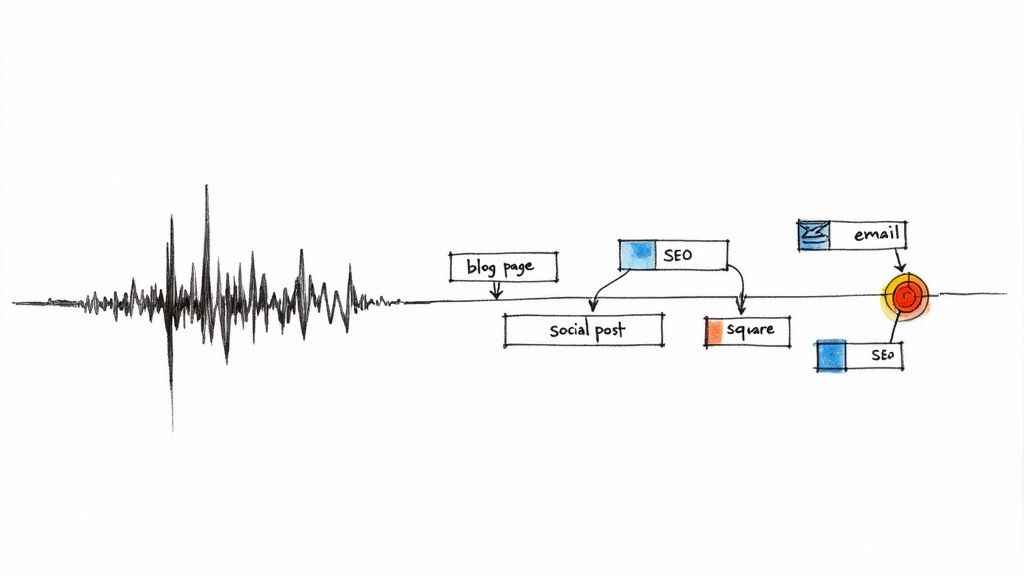
Without a text version, those brilliant insights from your latest podcast or the key takeaways from your webinar are completely invisible to search engines. Google can't "listen" to your audio file, but it can crawl every single word of a transcript. This one simple step makes your content discoverable, helping you show up for all the specific, long-tail keywords you naturally use in conversation.
Supercharge Your SEO Efforts
Spoken content is usually packed with relevant keywords, expert takes, and answers to the questions your audience is already asking. By turning that conversation into text, you create a dense, keyword-rich article that search engines absolutely love. This can immediately boost your visibility and start pulling in organic traffic from people searching for the very topics you covered.
By providing a full transcript, you essentially give search engines a complete blueprint of your audio or video content. This allows them to understand its context and relevance with much greater depth, leading to better search rankings.
Let’s put that into perspective. A single one-hour podcast episode can easily generate a transcript of over 8,000 words. That's not just a wall of text; it's a comprehensive resource that can attract backlinks, build your site's authority, and keep visitors on your page longer—all of which are fantastic signals for SEO.
Multiply Your Content Output
One of the biggest wins from transcription is the ability to repurpose your content with incredible efficiency. Instead of constantly brainstorming new ideas from scratch, you can spin a single recording into a whole suite of new assets. It's all about maximizing the return on your original creative effort.
Here’s how a single webinar recording can be repurposed:
- Blog Posts: The transcript can be cleaned up and formatted into a detailed, long-form blog post, complete with headings and images.
- Social Media Updates: Pull out the best quotes, stats, or quick tips to create dozens of engaging posts for Twitter, LinkedIn, and Instagram.
- Email Newsletters: Summarize the main points and fire them off to your email list, driving them back to the original video or the new blog post.
- Lead Magnets: Condense the core lessons into a downloadable PDF guide or checklist to capture new leads.
This approach saves a staggering amount of time and energy. As you think about how transcription fits into your bigger picture, it's also worth looking into technologies like content automation, which can help streamline these repurposing workflows even more.
Make Your Content More Accessible and Engaging
Transcription isn't just a marketing hack; it’s about creating a better, more inclusive experience for everyone. Providing transcripts and captions immediately makes your content accessible to people who are deaf or hard-of-hearing, a group that includes about 15% of American adults.
Beyond accessibility, transcripts cater to how different people prefer to learn and consume information. Some people just absorb information better by reading. Others might be in a noisy coffee shop or on a quiet train where they can't play audio. A transcript ensures your message gets through, no matter the person or the situation.
This commitment to accessibility also naturally boosts engagement. When people have multiple ways to interact with your content, they’re far more likely to stick around, understand your message, and share it. For creators looking to make this even easier, an AI podcast summarizer can quickly pull key points from a transcript, making it simple to create shareable highlights. At the end of the day, transcription builds a bridge to a wider, more connected audience.
Where Transcription Is an Absolute Game-Changer
While transcription is a fantastic tool for content creators, its real power is felt in industries where it’s not just a nice-to-have, but a daily necessity. We're talking about fields where accuracy isn't just important—it's everything. From the courtroom to the operating room, turning spoken words into a reliable written record is the bedrock of the entire workflow.
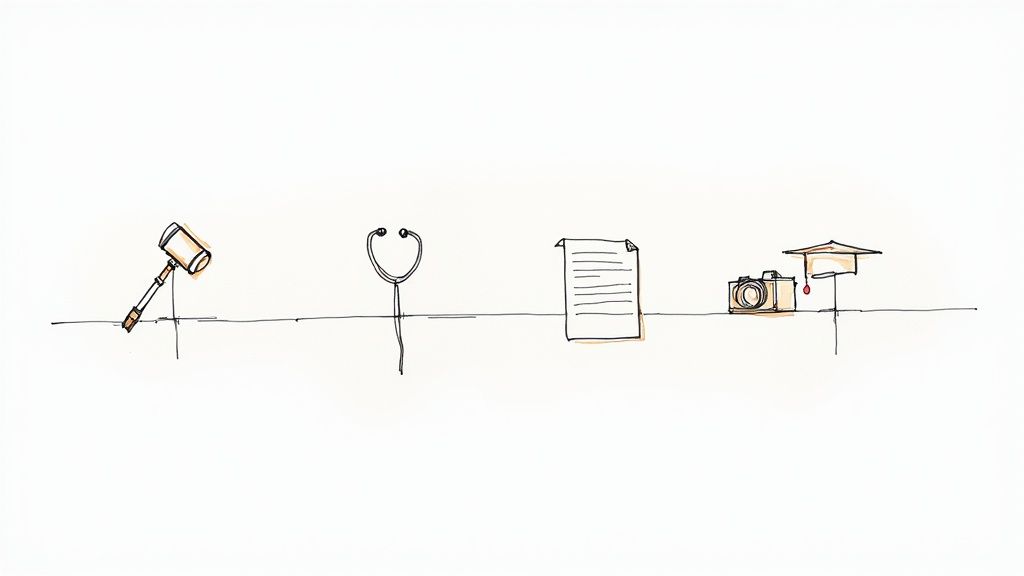
Think about a high-stakes legal case. The entire argument might rest on a single phrase from a witness deposition. One misinterpreted word could be the difference between winning and losing. This is exactly why legal pros rely on verbatim transcription—a method that captures every single word, stammer, and pause, just as it was said.
Precision in the Legal and Corporate Worlds
In legal settings, transcription creates the official, searchable record of all proceedings. It’s the raw material for building cases, prepping for trial, and filing appeals. There's simply no substitute.
Here's how it plays out:
- Depositions and Witness Interviews: Lawyers need a flawless record of testimony to pinpoint inconsistencies and build their arguments.
- Court Proceedings: Official court reporters produce transcripts that become the definitive account of everything said during a trial.
- Corporate Boardrooms: Companies transcribe board meetings and earnings calls to maintain airtight records for regulatory compliance and shareholder transparency.
For these professionals, there is zero room for error. A transcript isn't just notes; it's a legally binding document that establishes a single source of truth.
Accuracy and Efficiency in Healthcare
Healthcare is another world where transcription is fundamental, directly impacting patient care and keeping the administrative wheels turning. Doctors and specialists spend all day talking with patients, and every one of those details matters.
Medical transcriptionists take dictated notes, patient histories, and diagnostic summaries and turn them into structured, written records. This text then becomes part of a patient's electronic health record (EHR), creating a complete medical history that any provider can search instantly. It’s how a new doctor can get up to speed on a patient's condition in minutes.
Medical transcription is so much more than just taking notes. It's a critical piece of the patient safety puzzle, ensuring vital information is captured correctly and shared seamlessly with everyone on a patient's care team.
This specialized field is growing fast. In 2024, the global medical transcription market hit a value of about USD 79.35 billion, with North America making up over 45.8% of that. The market is expected to balloon to nearly USD 128.47 billion by 2033, which shows just how essential it is to modern medicine. You can dig into more stats about the growth of the medical transcription market on imarcgroup.com.
Insights and Accessibility in Media and Academia
Beyond the strict demands of law and medicine, transcription is what makes deep research and global communication possible. Academics doing qualitative research live by their transcripts of interviews and focus groups. Having a text version of their conversations allows them to tag data, spot patterns, and pull direct quotes to back up their findings.
It’s the same story in media and entertainment, where transcription is the first step in making content accessible to everyone.
It serves a few key purposes:
- Subtitles and Closed Captions: Transcripts are the foundation for the subtitles that let people watch content in another language or with the sound off.
- Video Production: Editors use transcripts as a roadmap to find specific soundbites and clips in seconds, dramatically speeding up post-production.
- Global Reach: Translators start with a source-language transcript to create accurate versions for international audiences.
From ensuring justice is served to improving patient outcomes and sharing knowledge across borders, the applications are incredibly diverse. Transcription is the bridge between spoken words and usable information, proving its worth in any field where getting it right is the only option.
How To Choose The Right Transcription Service
Trying to pick a transcription service can feel overwhelming. A quick search turns up dozens of options, all promising the moon. The secret to cutting through the noise is to zero in on what your project actually needs. If you take a moment to evaluate a few key factors, you can find a service that gets the job done right without costing a fortune.
The first thing I always consider is accuracy. You'll see AI services touting impressive accuracy rates, but those numbers are usually based on perfect, studio-quality audio. If you're dealing with background noise, multiple people talking over each other, or thick accents, you might find that only a human-powered service can deliver the clean transcript you're after. For your team's internal meeting notes, a quick AI draft is probably good enough. For legal evidence or academic research? Not so much. Precision is everything.
Defining Your Project Requirements
Before you even start looking at providers, map out your needs. This simple step acts as a filter, guiding you straight to the right kind of solution and keeping you from paying for features you'll never use. Knowing your priorities from the start makes the whole process a lot less complicated.
Here are a few questions to get you started:
- Turnaround Time: How fast do you need this back? AI tools can turn around a transcript in minutes. A human transcriber might take hours or even a few days. Be honest about your deadlines.
- Audio Complexity: Are you working with a crystal-clear recording of one person speaking? Or is it a chaotic conference call with technical jargon and overlapping conversations? The tougher the audio, the more you should lean toward a human or specialized service.
- Security Needs: Does the audio contain confidential information? If you're handling sensitive data, things like encryption, secure file handling, and a rock-solid privacy policy are non-negotiable.
Comparing Pricing Models and Value
Most transcription services bill you in one of two ways: per-minute rates or a monthly subscription. The per-minute model is as straightforward as it gets, making it perfect for one-off projects. You pay for exactly what you use, with prices typically starting around $0.25 per minute for AI and jumping to $1.50 or more for a real person.
Subscriptions, on the other hand, give you a bucket of minutes each month for a flat fee. This is a game-changer for anyone with a steady stream of work, like a podcaster with a weekly show or a team that records every meeting. Do a quick calculation of your monthly needs to see which model saves you more money in the long run.
When you're looking at the cost, don't just stop at the price tag. The real value is finding that sweet spot between price, accuracy, speed, and security. A cheap transcript that's full of errors and takes you hours to fix is no bargain at all.
A Checklist For Making Your Final Choice
Once you've got your requirements down, you're ready to start vetting some options. To make sure you're asking the right questions and making a smart choice, I've put together a handy checklist based on my own evaluation process.
Checklist For Selecting A Transcription Service
This table will guide you through the essential criteria for evaluating a transcription provider, ensuring you choose one that truly fits your project's demands.
Using this checklist to compare a few top contenders will give you the confidence that you're picking a partner, not just a service.
Got Questions About Transcription? Let's Clear Them Up.
As you start digging into transcription, you're bound to have a few questions. That's totally normal. Here, I'll tackle some of the most common ones I hear from creators and teams to clear up any lingering confusion and help you move forward with confidence.
Even with all the incredible tech out there, a lot of people wonder how machines really stack up against a human touch. Getting a handle on these differences is the key to picking the right tool for what you need to do.
How Accurate Is AI Transcription Compared To A Human?
AI transcription has gotten incredibly good, it's true. Top-tier services can hit 95-99% accuracy, but that’s under perfect lab conditions—think crystal-clear audio, one person speaking, and zero background noise.
The moment things get messy, human transcribers still have the clear advantage. People are pros at navigating heavy accents, untangling conversations with overlapping speakers, and understanding niche jargon. They also get the context and nuance that an AI just can't grasp.
So, when does it matter? If you're working with something where every word counts—like legal depositions, in-depth research interviews, or a script for a major film—a human is your best bet for near-perfect accuracy. But for everyday tasks like meeting notes or first-draft content, where you just need the gist of it quickly, AI is a fantastic, cost-effective tool.
What Is The Difference Between Transcription And Closed Captions?
This is a big one. While transcription and closed captions both turn speech into text, they're built for completely different jobs. You can think of a transcript as the raw script of a play, while captions are the lines being delivered on-screen, timed perfectly with the action.
A transcription is a straightforward text document of everything that was said. It's often formatted with speaker labels and timestamps to make it easy to read, search, and analyze. It’s a record you can use for content repurposing, documentation, or study.
Closed captions (CC), on the other hand, are the text you see on the video screen itself. They are synchronized to the audio, specifically designed to make videos accessible for viewers who are deaf or hard-of-hearing.
The real difference is in how you use them. A transcript is a separate document for reading and reference. Captions are part of the viewing experience, baked right into the video player.
Captions also add another layer of context by including important non-speech sounds, like [applause] or [door closes], to paint the full picture for the viewer. Simply put, a transcript is the source text; captions are the real-time display of that text.
How Can I Improve Audio Quality For Better Transcription?
Here’s a hard truth: the quality of your transcript depends entirely on the quality of your audio. It's a classic "garbage in, garbage out" scenario. The good news is that a few small tweaks can make a massive difference, whether you're using an AI or working with a person.
If you do just one thing, make it this: use an external microphone. Your laptop or phone mic just won't cut it. A dedicated mic is the single best investment you can make for capturing clear, crisp audio.
Here are a few more pro tips to clean up your recordings:
- Find a Quiet Space: This seems obvious, but background noise from traffic, an AC unit, or even a humming refrigerator can wreak havoc on a recording. Find the quietest spot you can.
- Get Close to the Mic: Position the speaker close to the microphone. This ensures their voice is the primary sound being captured, not the echo of the room. A consistent volume and pace also help a lot.
- Mic Up Everyone: If you’re recording an interview with two or more people, give everyone their own microphone. This is the secret to avoiding a jumbled mess when people inevitably talk over each other.
- Choose the Right File Format: If you have the option, always record in a high-quality, uncompressed format like WAV or FLAC. Compressed files like MP3s toss out audio data to save space, which can make transcription much harder.
Putting in a little effort before you hit record will save you a ton of headaches later. Clean audio means a more accurate transcript and far less time spent on tedious corrections.
Ready to turn your audio and video into accurate, searchable text in minutes? With Whisper AI, you can get started for free. Our AI-powered platform not only transcribes your content but also identifies speakers, adds timestamps, and generates concise summaries to help you find key insights instantly. Join over 50,000 users and see how easy transcription can be at https://whisperbot.ai.
